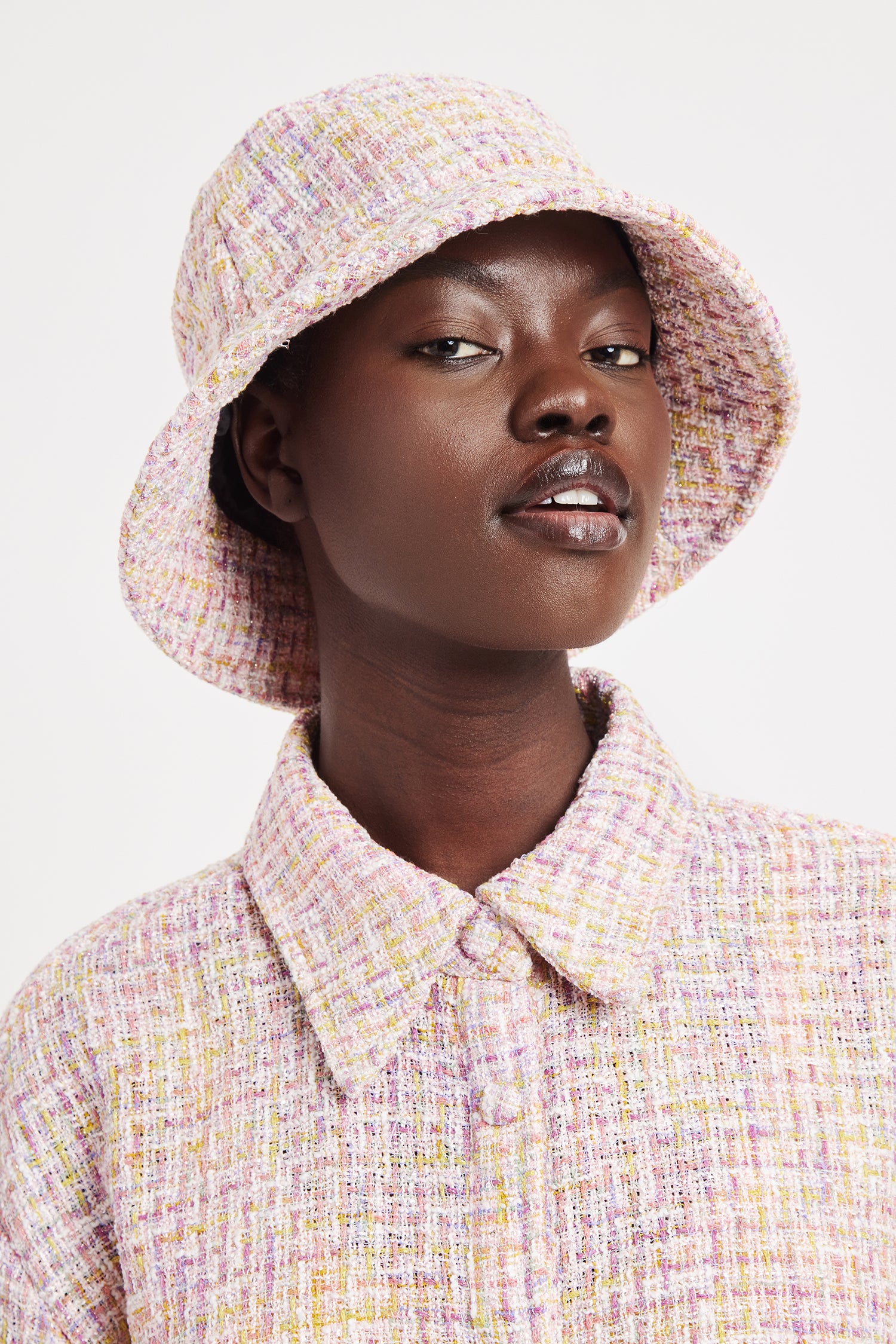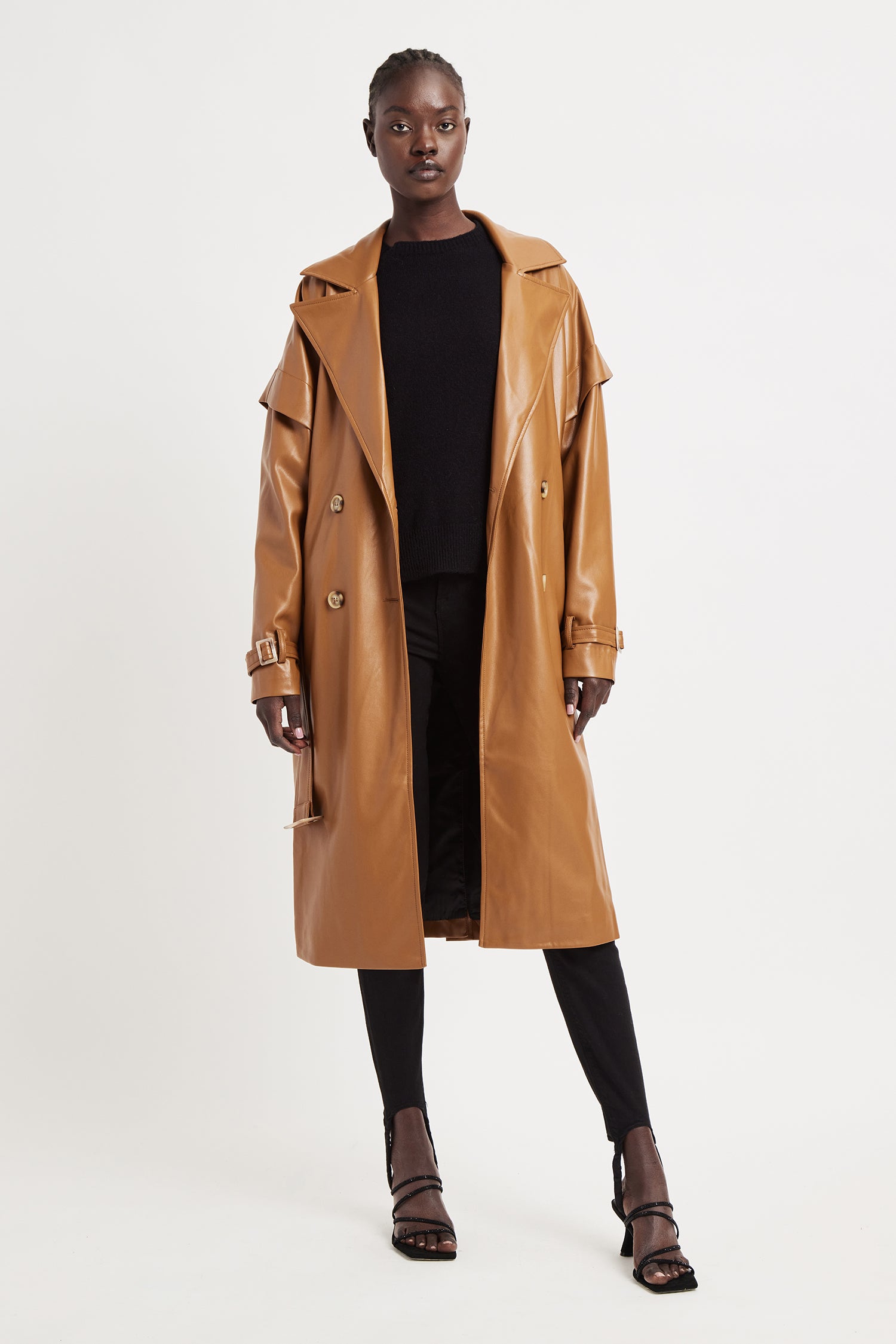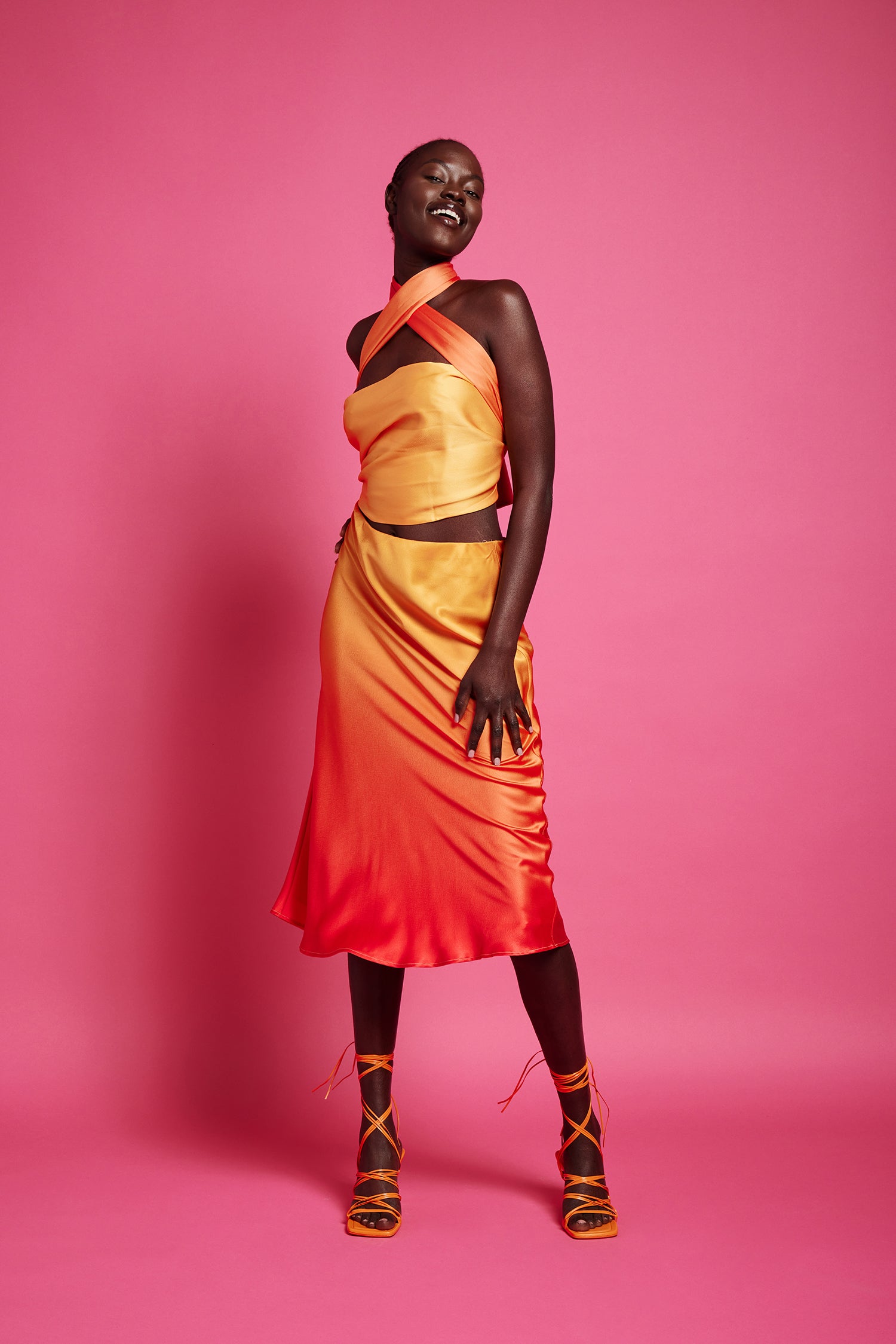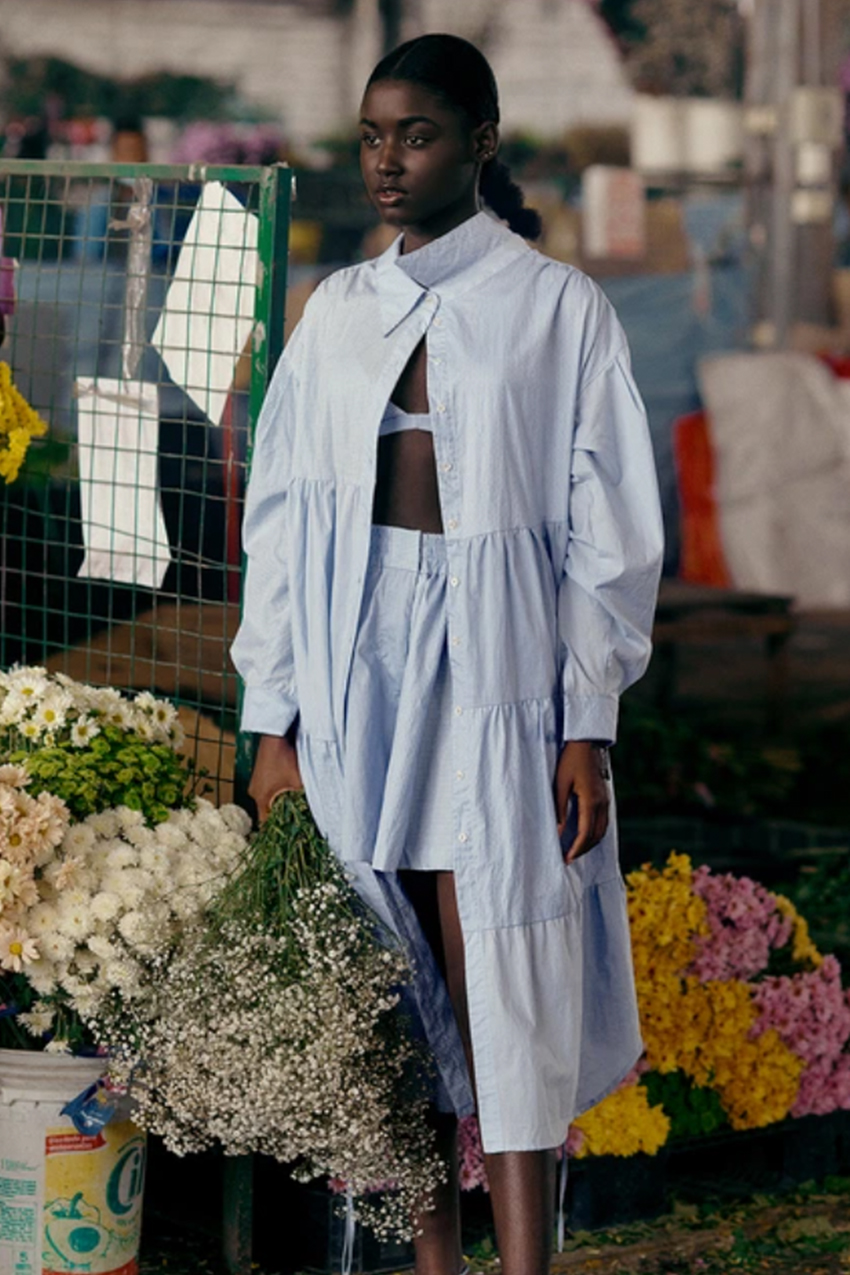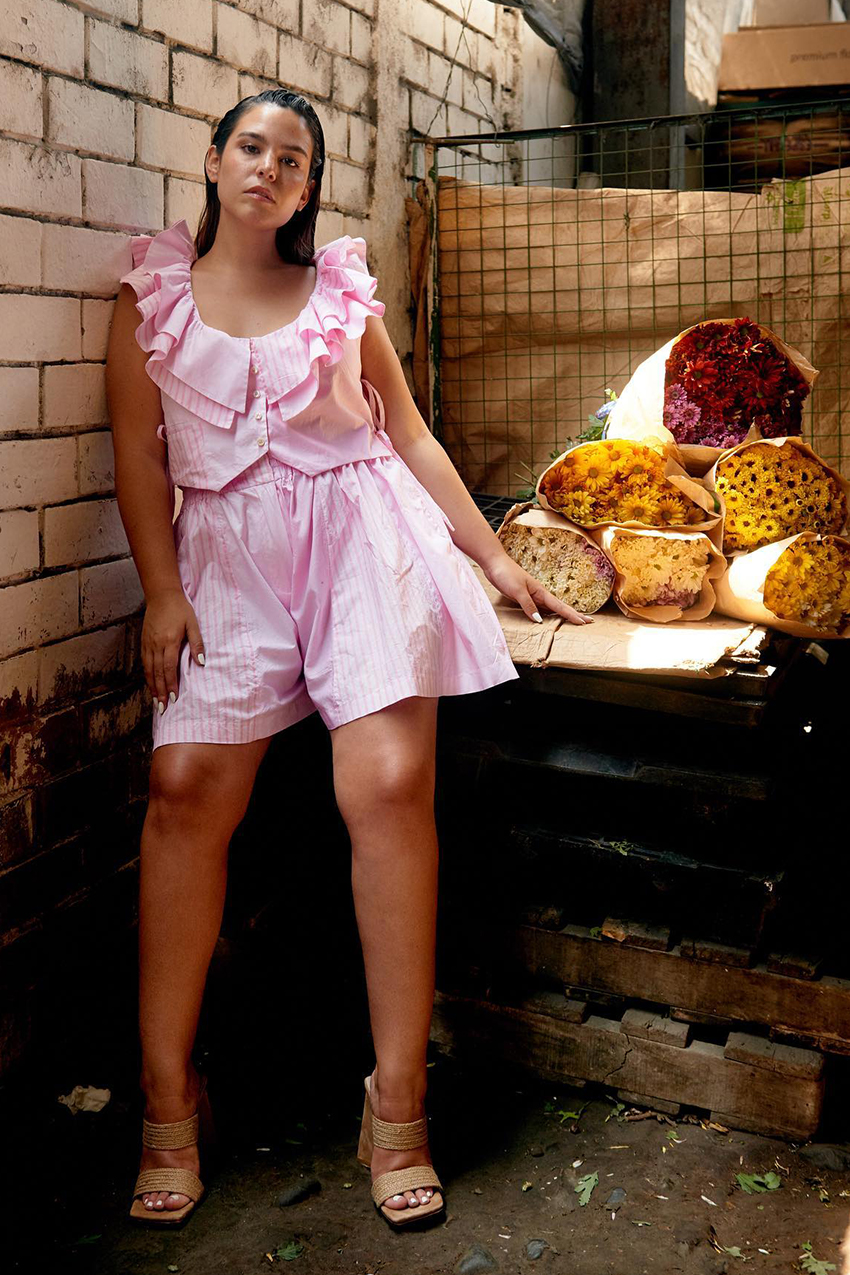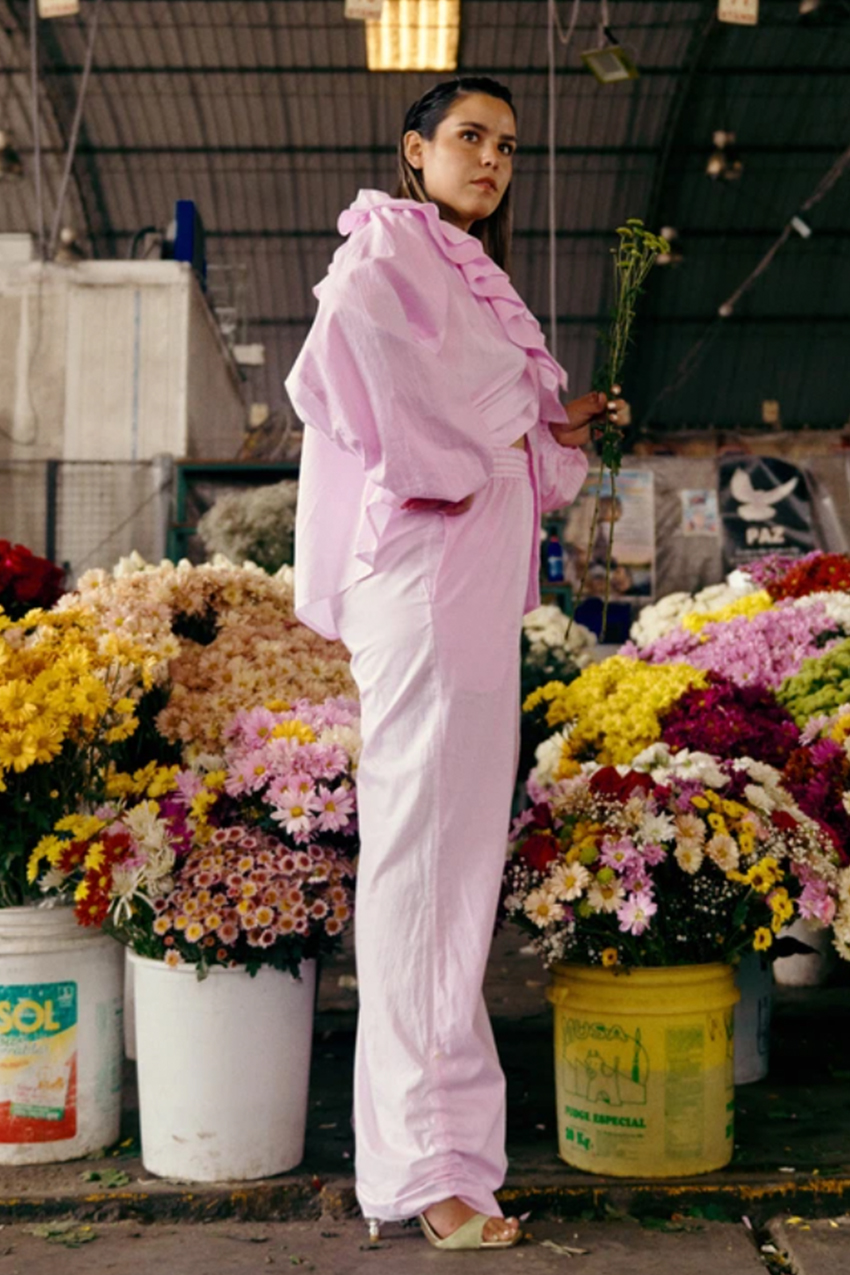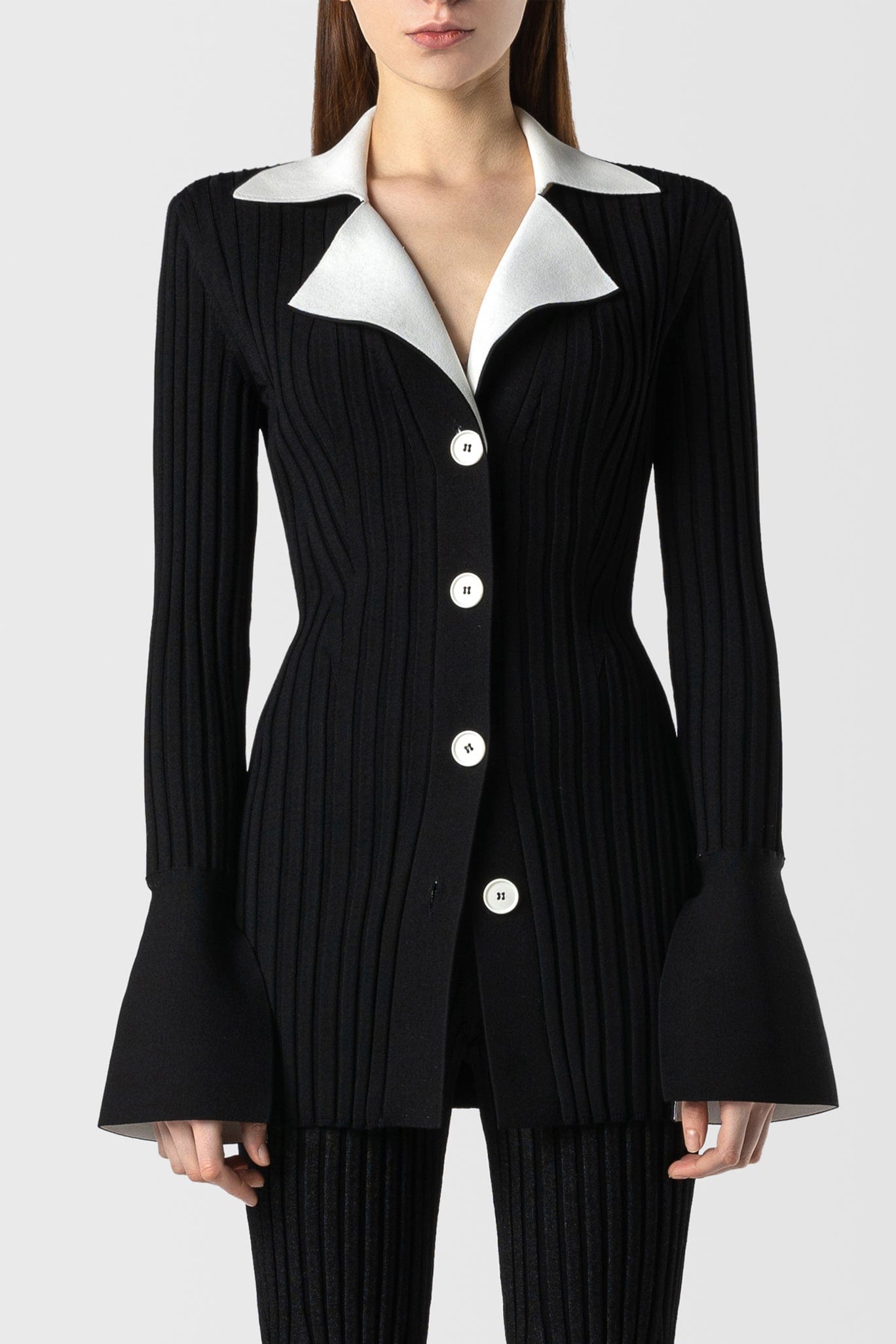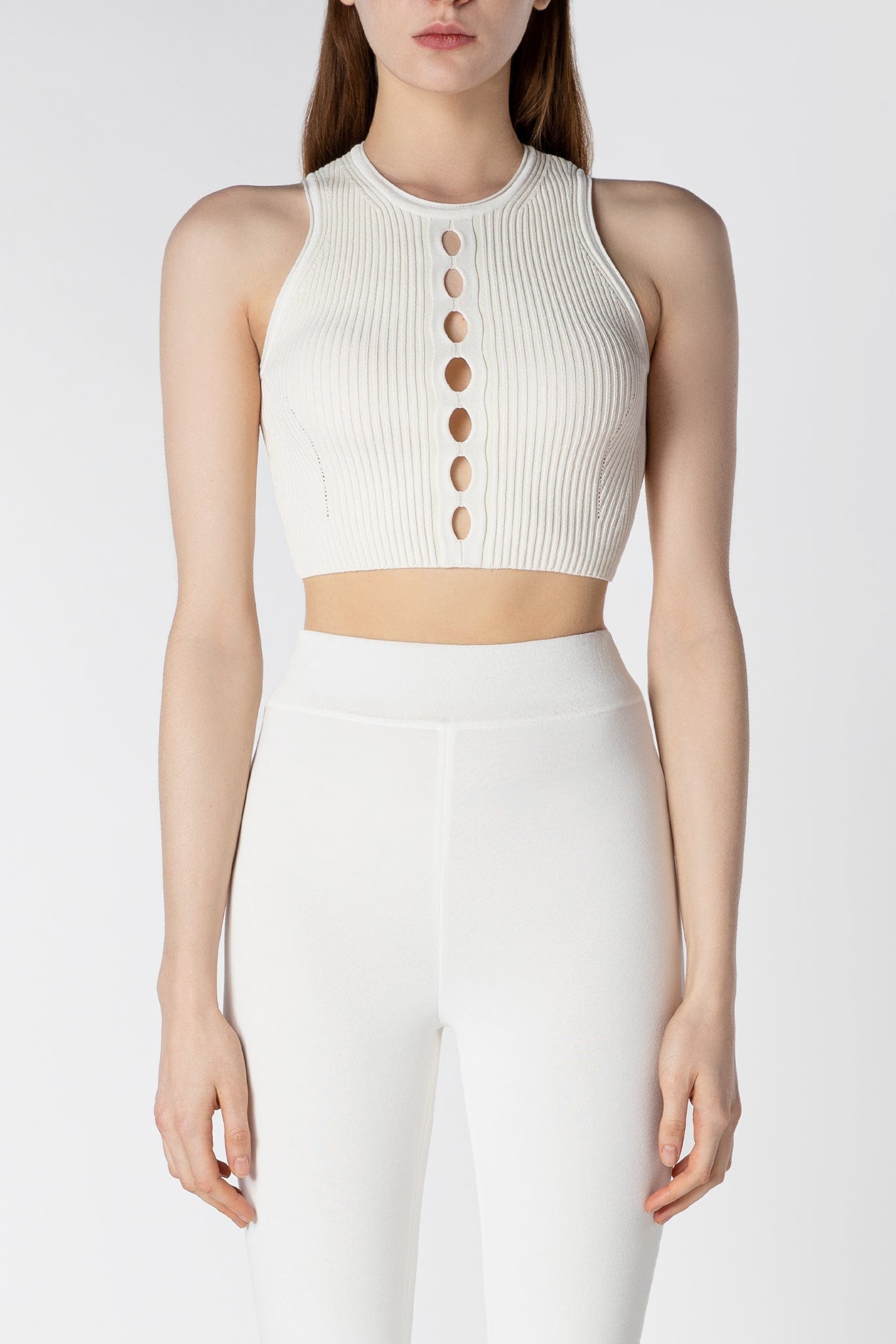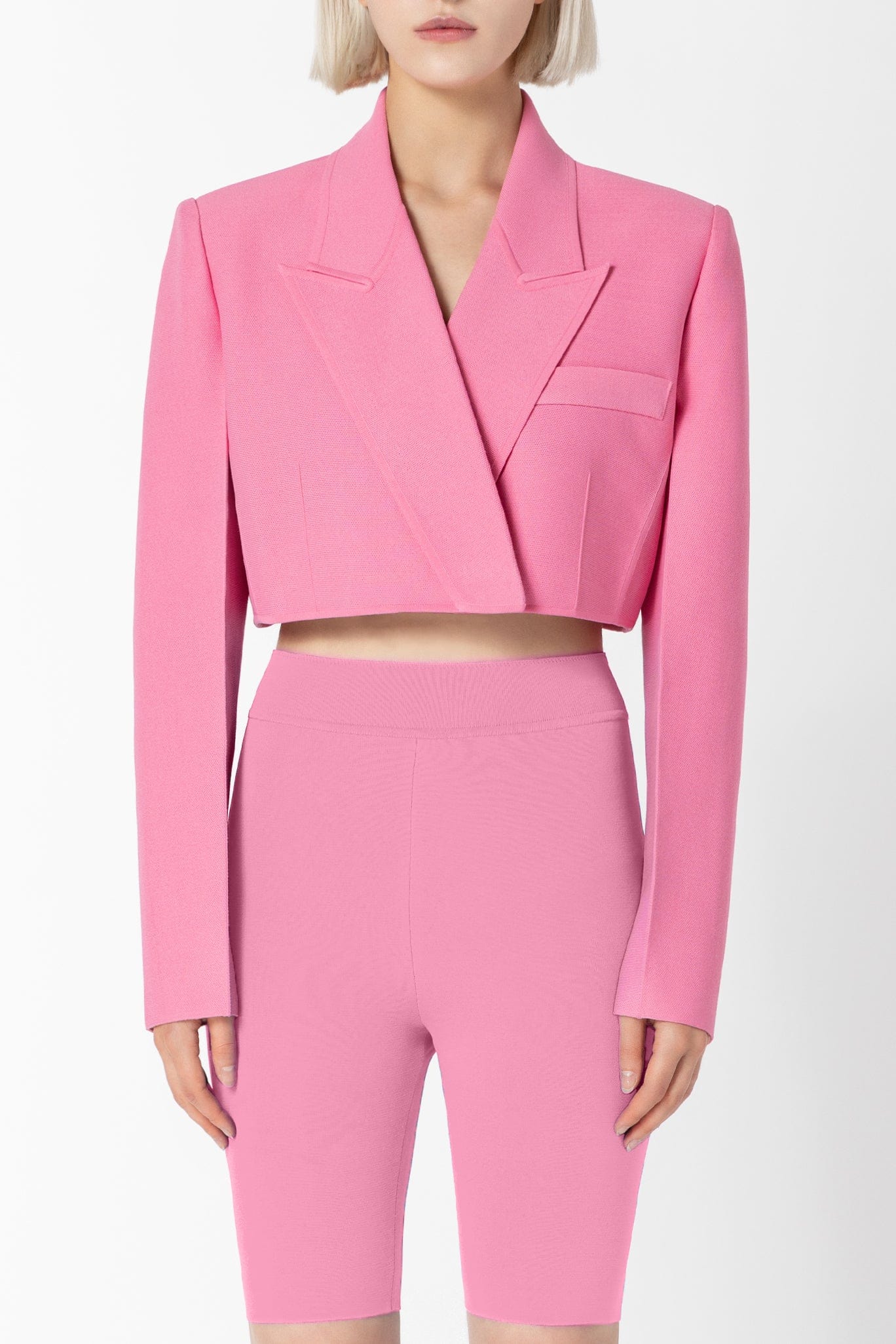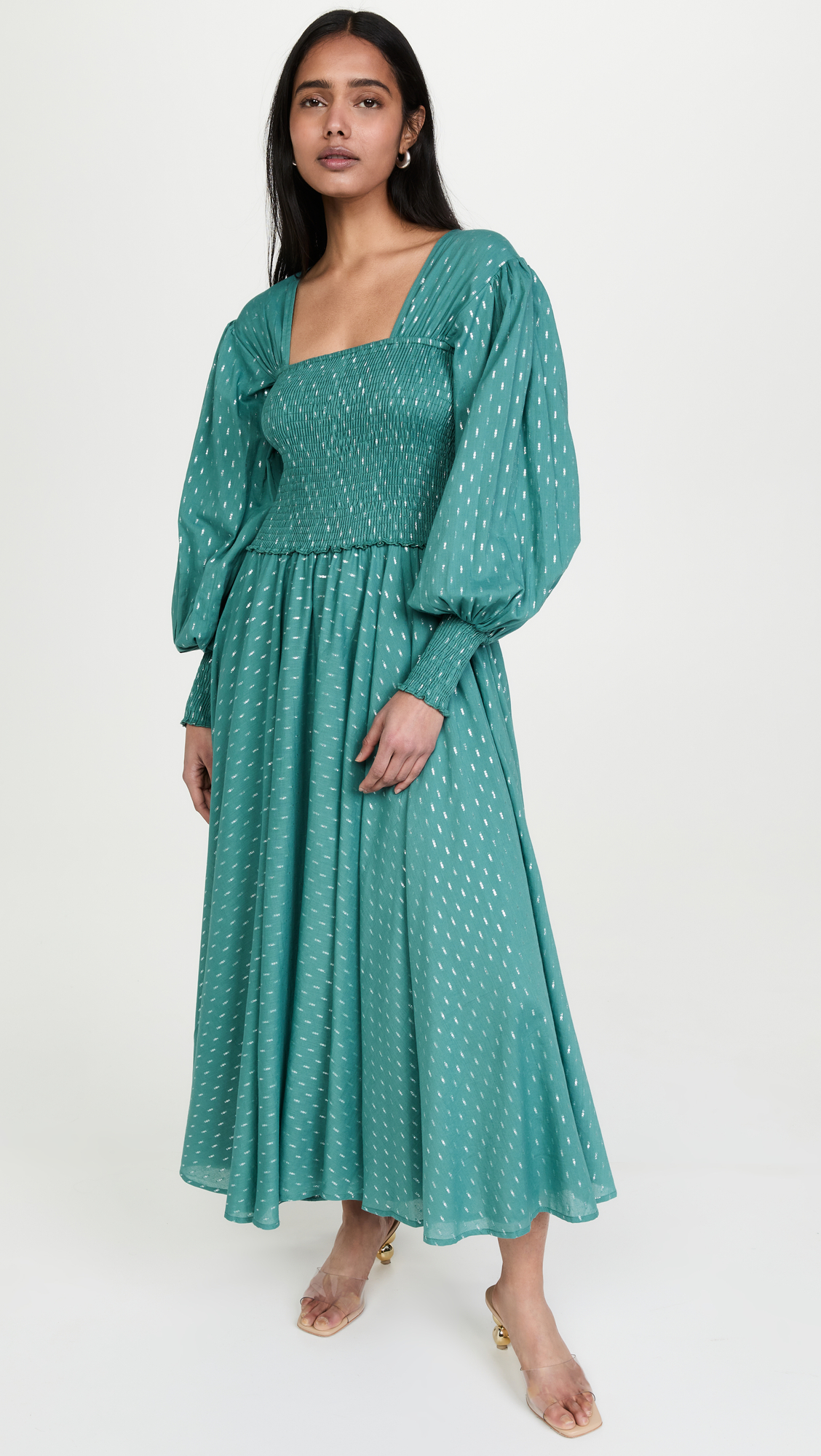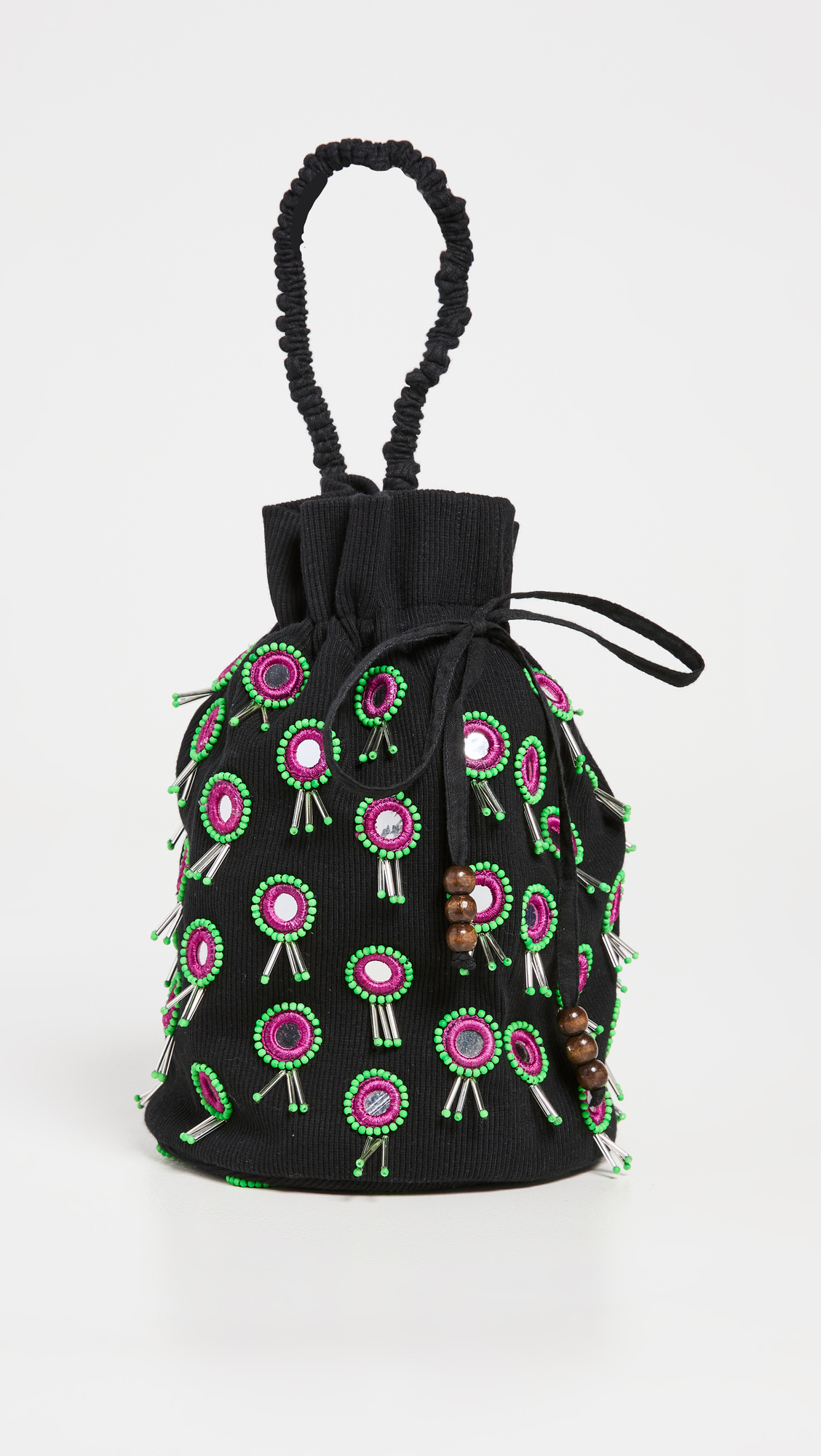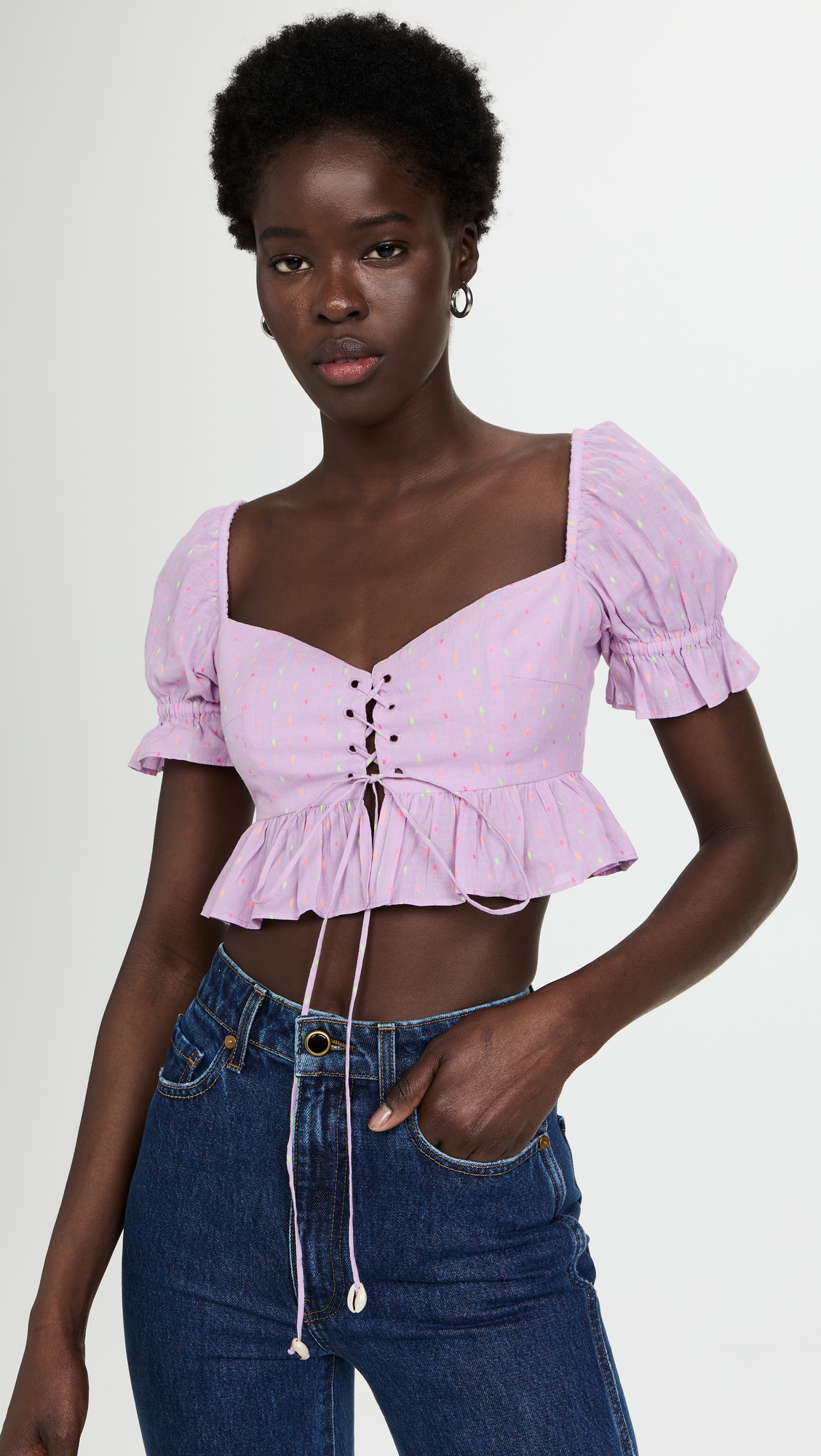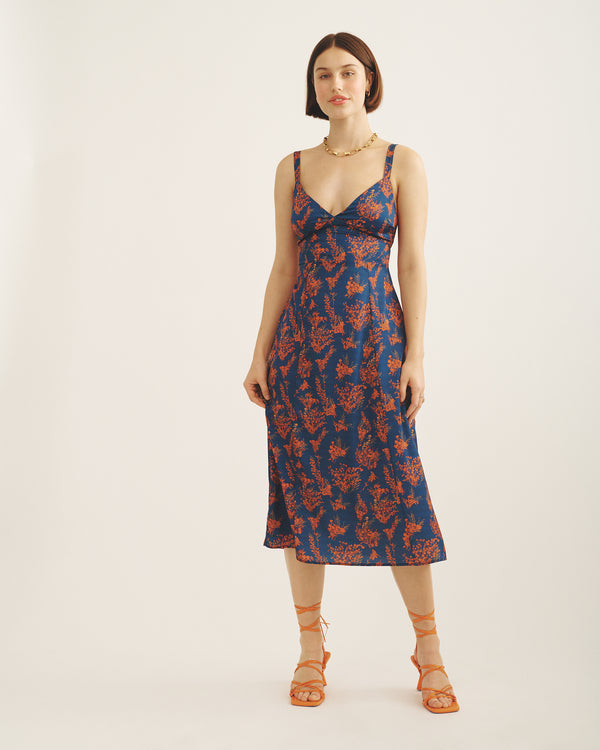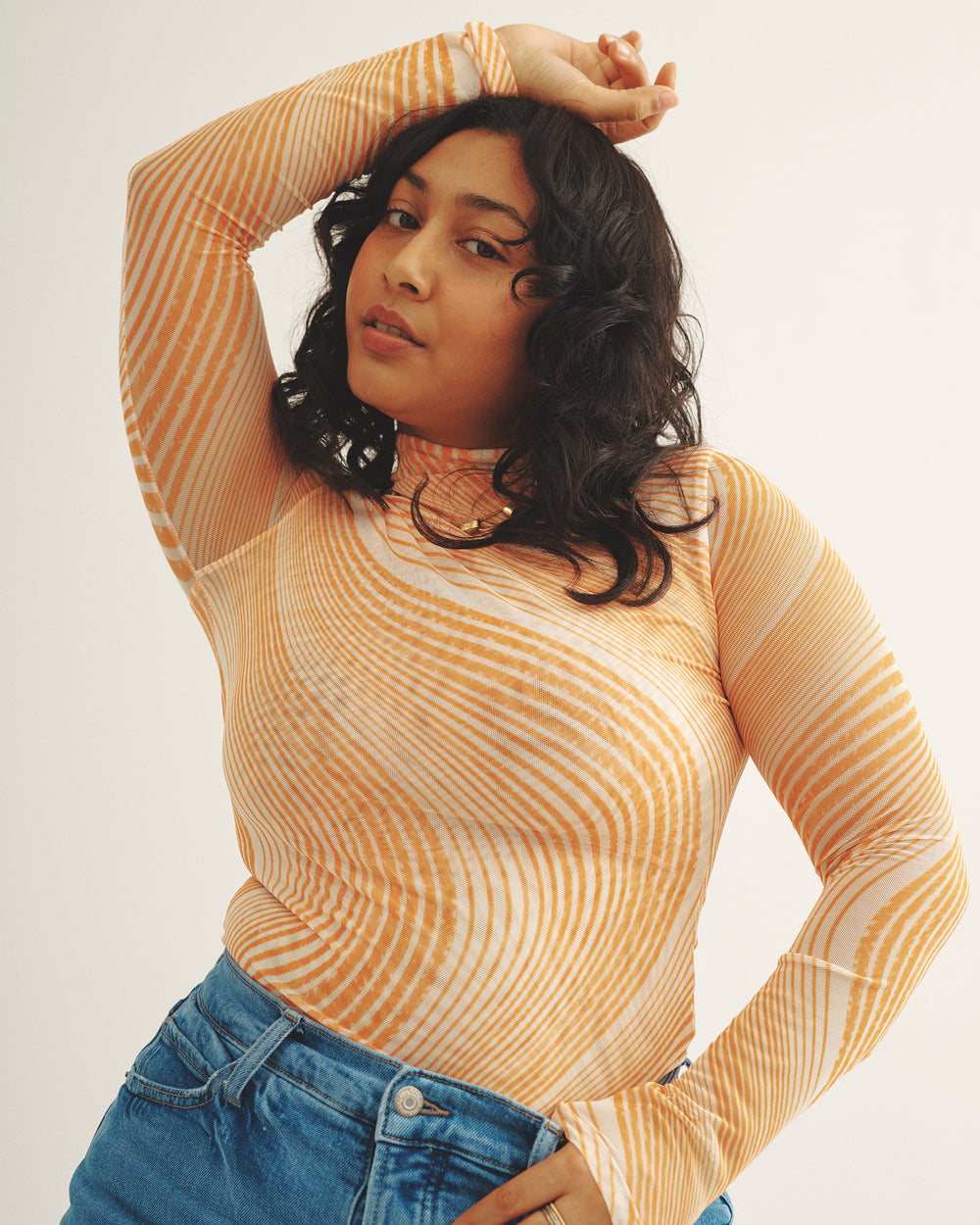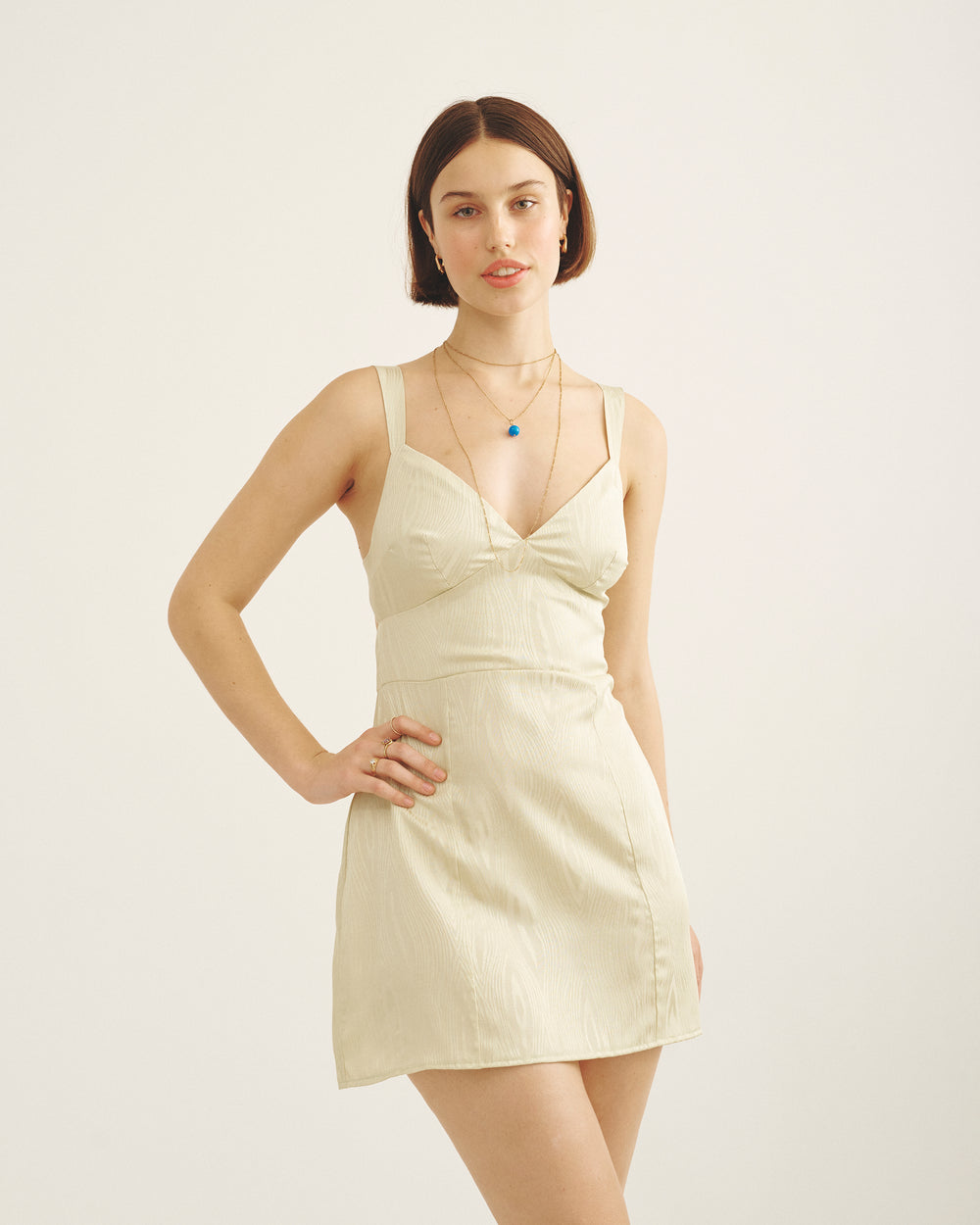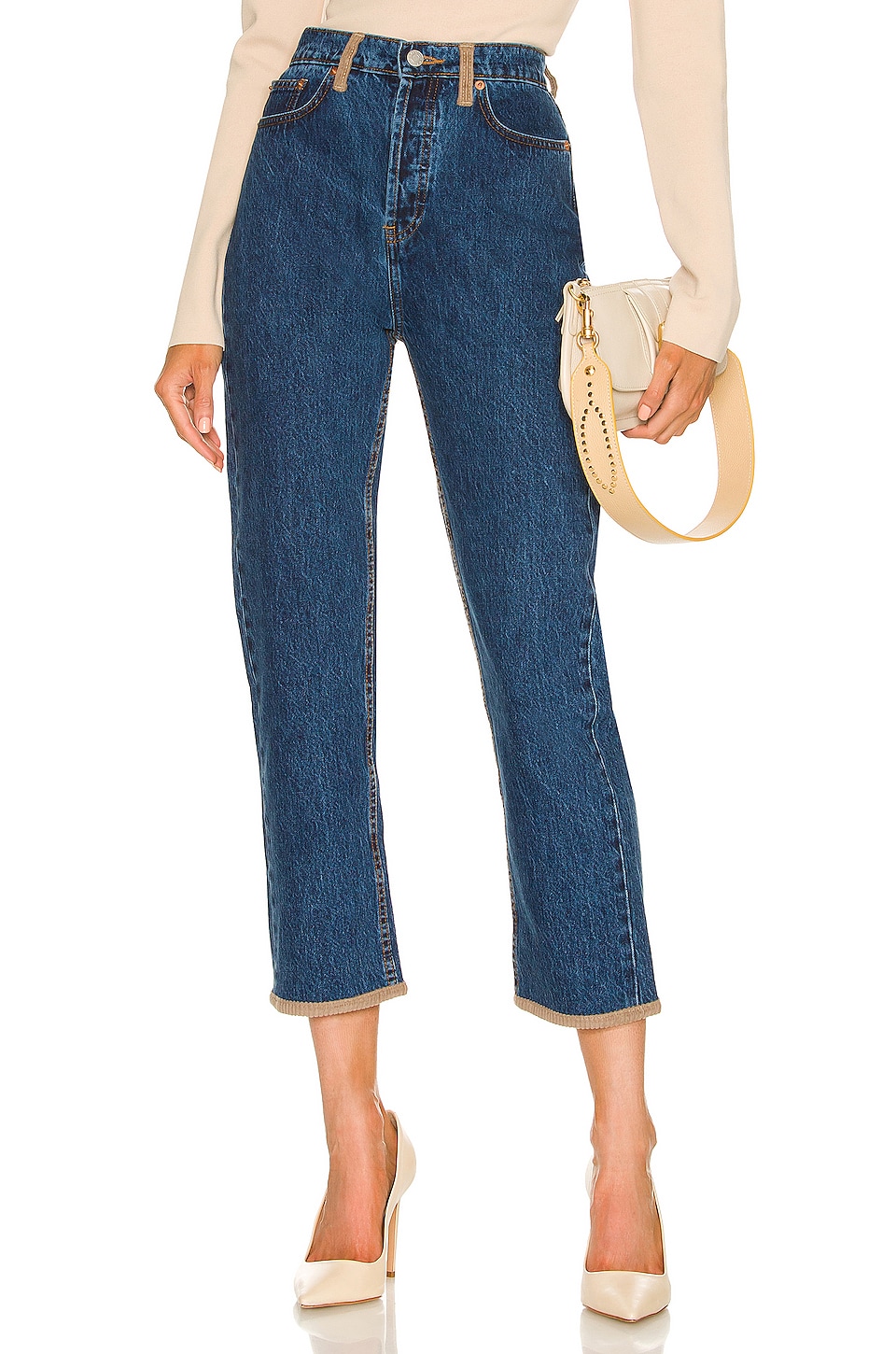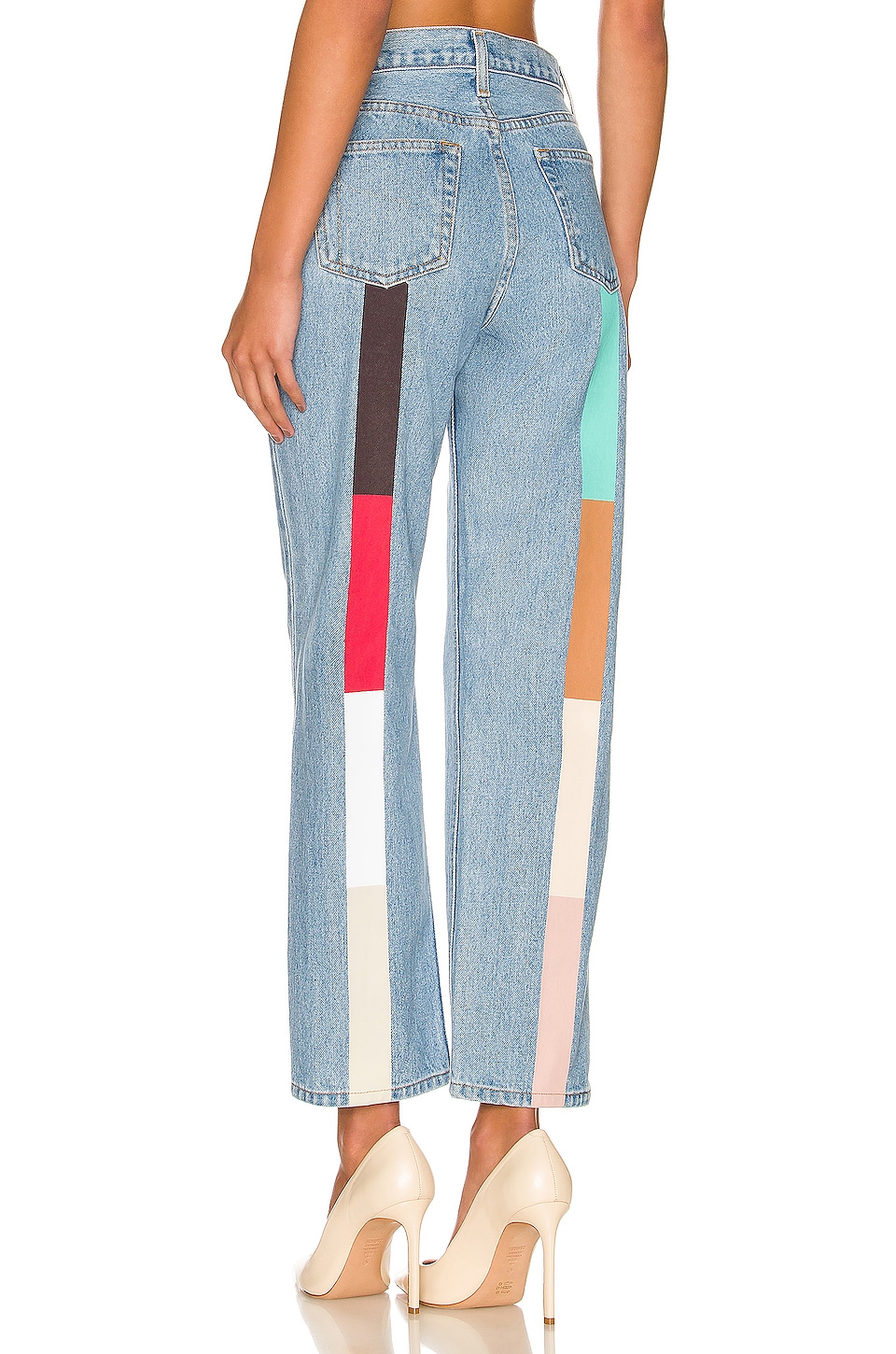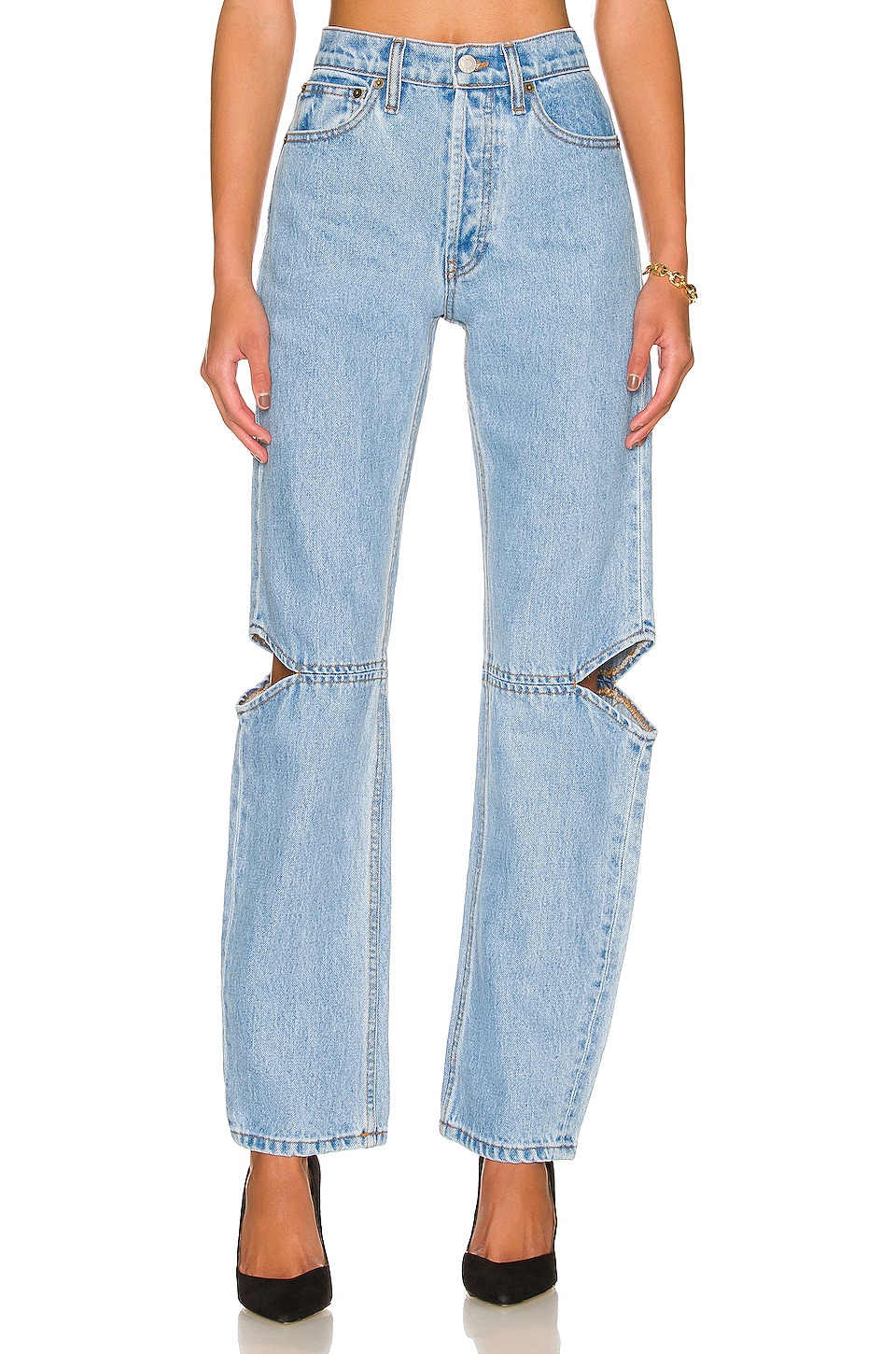What Exactly Is a Sustainable Fabric? 8 Experts Spill the Tea
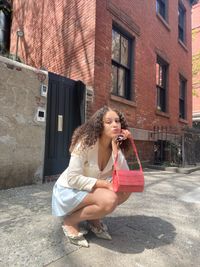
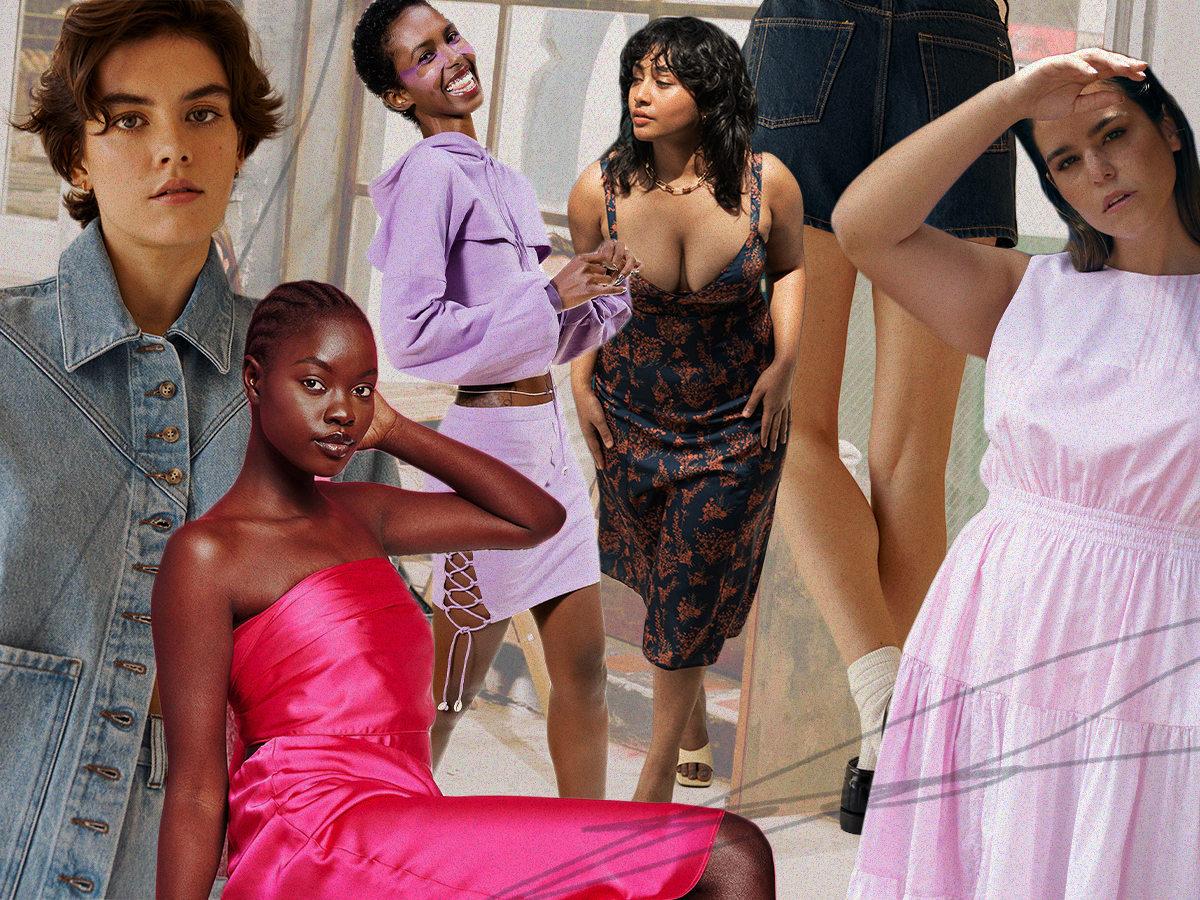
Every once in a while, I’ll be in a state of anxiety about the ecological impacts of the fashion industry. Maybe I’ve found out that a TikToker spent an egregious amount of money for a fast-fashion shopping haul, or I’ve read a recent article about how the majority of clothing donated to thrift stores is exported to countries in Africa and South America where it will end up in landfills and never decompose.
Regardless of what's riled up my anxiety around the state of the existential climate crisis, I know I’m not the only one who has felt this way at one point or another. Of course, I must preface this by saying that it’s complicated to love fashion and still worry about the planet (I'm a fashion editor, so I should know). That being said, I do believe that plenty of people aspire to create and consume fashion more mindfully.
On the individual level, there are so many ways to adopt more sustainable practices to your wardrobe (i.e., second-hand shopping, buying from sustainable brands, and investing in pieces that will last you longer). Beyond that, to truly combat the ecological footprint of the fashion industry, we have to think about textile production. In the fashion industry, producing fabrics accounts for 10% of the total carbon footprint of the entire world (above maritime shipping and flight combined) and 20% of the world’s clean water waste. That’s not something one person can solve by changing their shopping habits; it will take a collective reckoning, more global regulations, and a shift in the way we produce, consume and recycle clothing.
And if you’re starting to feel overwhelmed by how much work there is to do to change this, don’t fret because there is an abundance of fashion brands that have begun to change the way we view sustainable textile production. Ahead, we’ve spoken to eight founders who have recognized issues in textile production and are using their brands to change the industry.
From making corn-based biodegradable faux furs to using 3D printers to make sustainable knitwear, these founders are changing the world, one scrap of fabric at a time.

Apparis is a New York City based sustainable lifestyle and fashion brand founded by the French duo Lauren Nouchi and Amelie Brick. The contemporary brand first made waves in the fashion industry at its founding in 2016 with its vegan faux-fur coats. The brand since then has expanded into ready-to-wear and even home décor that champions recycled fabrics. The brand is leading the forefront in innovating new sustainable alternative textiles, so we spoke with co-founder and creative director of Apparis, Lauren Nouchi herself, on why revolutionizing how we make clothes is a part of the brand’s larger mission.

How did you break into the fashion industry, and what compelled you to found Apparis?
Lauren Nouchi: Since a young age, I have always shown interest in the fashion industry, and my family has a background working in retail. Before Apparis, I worked for luxury retail companies, including Louis Vuitton and Saint Laurent, and continued developing my passion for products and overall for the industry. While working at these fashion houses, I quickly understood that I wanted to create a brand that would challenge the industry regarding vegan and sustainable fashion.
What's one fact about textile production's impact on the environment that you think surprises most consumers?
LN: Textile production accounts for one-fifth of the world's industrial water pollution. That is on top of the amount of waste that is produced. The waste and pollution negatively impact our environment, which has social and societal effects. Textile production is a significant contributor to the greenhouse emissions generated by the industry, up to 71%, and fashion accounts for 4 10% of human-made emissions.
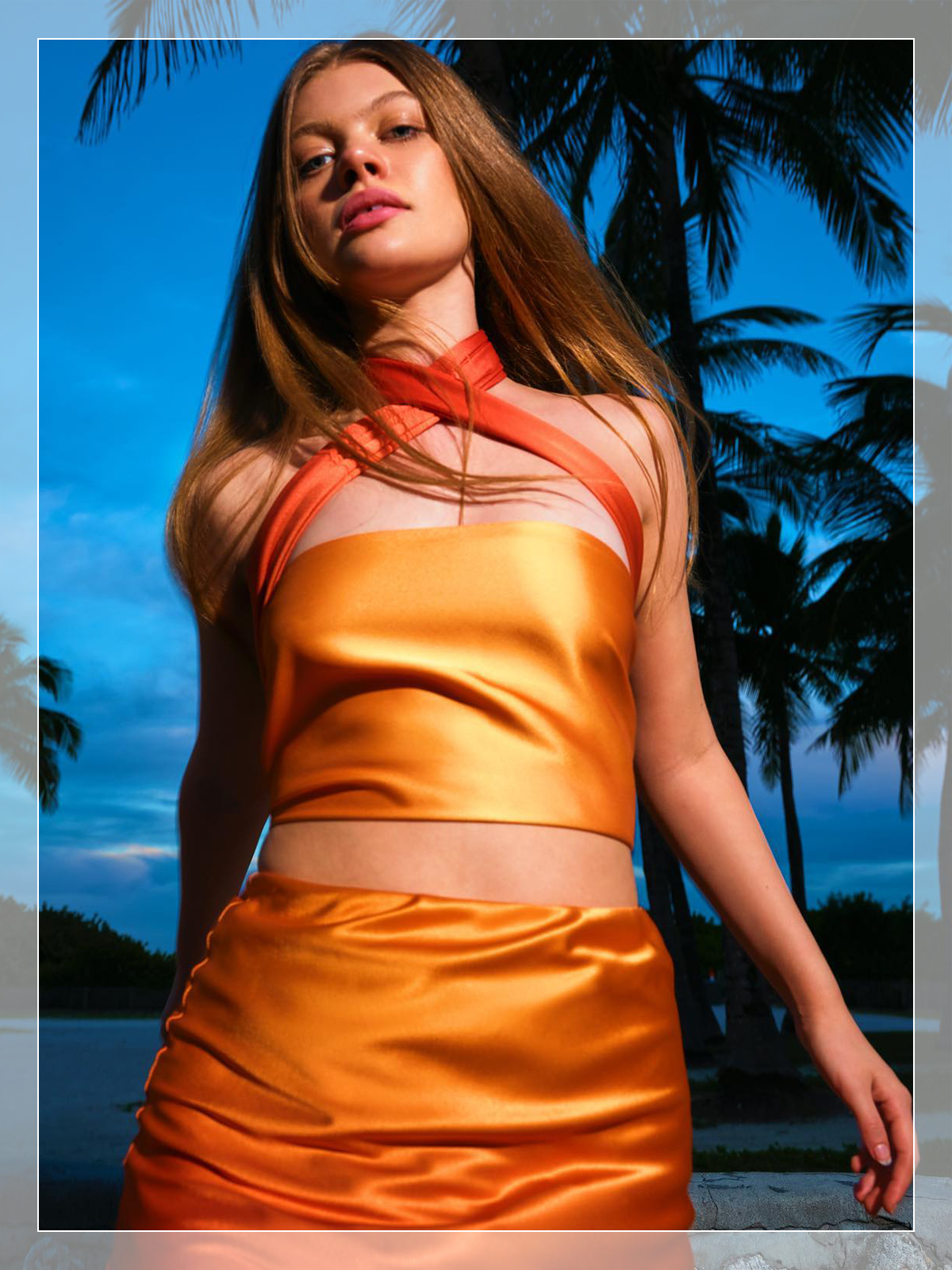
With your expertise, how would you define what a sustainable fabric is?
LN: Fabric cannot be sustainable just because it is made with more eco-friendly fibers, like organic cotton, or because it is "recycled.” A genuinely sustainable material is produced consciously; consideration is given to every stage of production. And there’s an active effort to reduce environmental impact—like how much water is being used or if the cultivating and harvesting of natural fibers is degrading the soil in the area.
Why is revolutionizing the way we produce textiles important?
LN: Textiles are a huge part of our lives! Textiles are vital to so many industries, not just fashion. Millions of tons of textiles are produced every year, and a large part of that ends up in our landfills. The methods we are taking now to reduce our impact cannot keep up with the scale and speed of production. While it’s excellent, the industry has moved towards being "green,” we need to revolutionize our methods now to feel a positive change.
How is Apparis applying sustainable textile production practices to its collections?
LN: We are excited about introducing our Recycled Marled Knit program for F/W 22. The fibers and production methods are certified by the Global Recycling Standard (GRS) and OEKO-TEX. The fibers that make up the yarn are traceable, so we know where it came from and can be confident it was processed and produced responsibly. The mill operates GRS-certified machines and has adopted circular operation practices, like reusing the waste from yarn production and recycling the water they use in their facilities. They are also partnered with the Veolia Group, which works with companies from different sectors to find ecological and sustainable production solutions.
What’s one fabric you always recommend consumers avoid, and which one would you replace it with?
LN: Genuine leather and furs! The chemicals used to tan leather are extremely hazardous and contribute to land and water pollution. These chemicals are often dangerous and can be toxic for the people who work with them, people in the local community, and native species. We also love our furry friends, so the prevalent animal abuse that occurs is not something we can ignore. There is no reason to shop genuine when great sustainable options are available, like our Koba faux fur made from Sorona fibers derived from corn, which can offer the same look, feel, and durability as genuine.
Besides checking the label to ensure that consumers are buying more eco-friendly fabrics, what tips would you give to consuming more mindfully?
LN: Consume smart and consume less! Research where you’re shopping and try to shop with brands that are transparent about their current practices and the steps they are taking to do better. Practicing circularity is also a great way to be more eco-friendly; the easiest way would be to shop secondhand. We recently launched Reapparis, a platform for our customers to buy and sell preloved Apparis pieces to encourage consumer circularity.

What are your hopes for the future of sustainability in fashion? And what role do you hope Apparis plays in shaping the industry’s impact on the environment?
LN: That the fashion industry comes to a consensus on where we stand with genuine leather and fur. We believe that the future of fashion is vegan, so it is vital that sustainable products become more attainable. We want to encourage others in the industry that making these changes is possible by offering sustainable products at an affordable price point while continuing to work on reducing our impact. One of our primary goals is to remove all virgin plastics completely and, eventually, all synthetics from our collections and make the switch to bio-based materials. Still, the truth is that we cannot do that alone. We need the larger industry’s support and interest in bio-based alternatives so they become more accessible and widely adopted.
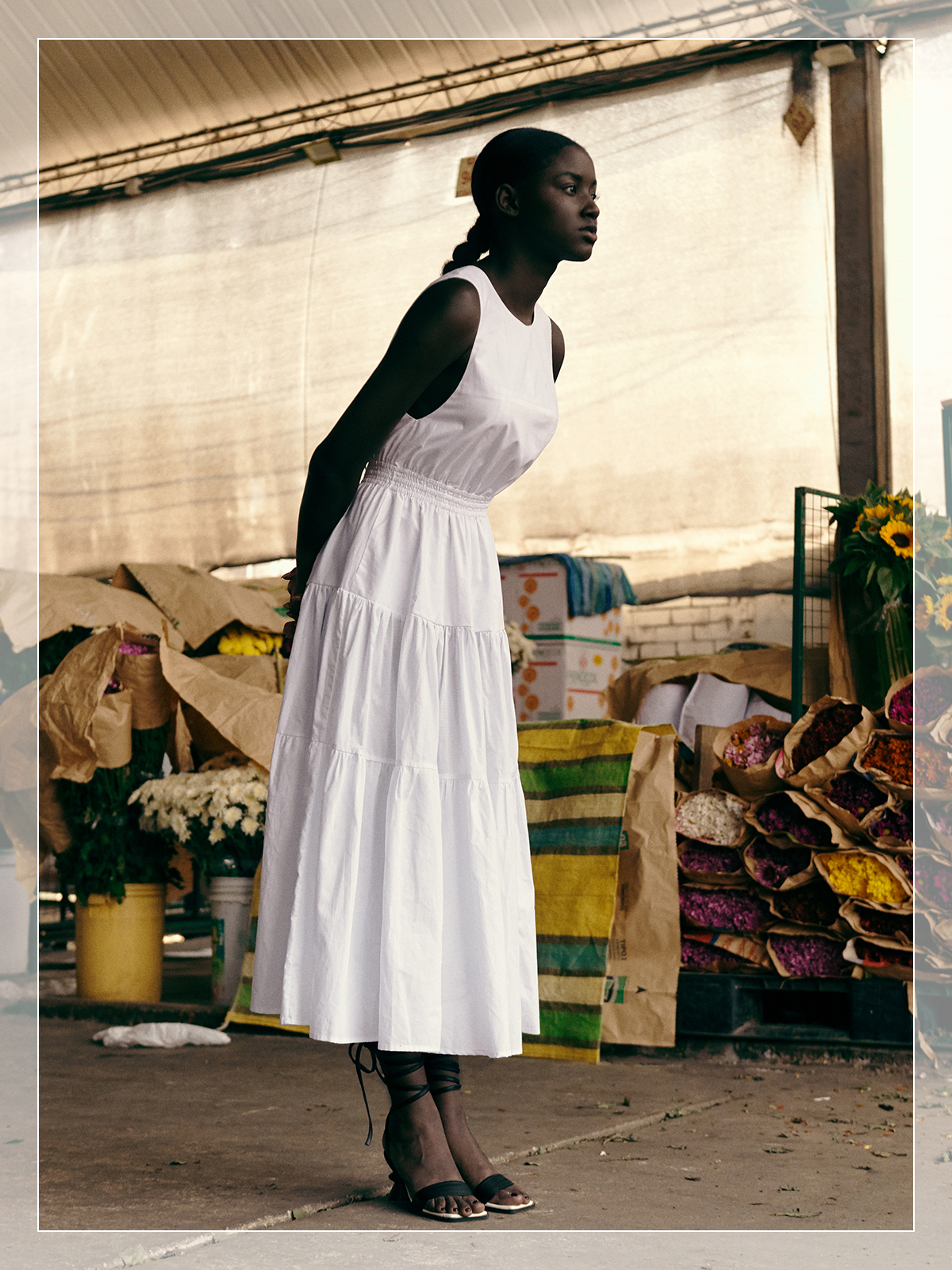
Leftover textiles happen to be one of the biggest contributors to the fashion industry’s ecological footprint, and the ready-to-wear fashion brand Loti is trying to mitigate that impact. Founded by the Peruvian-born (now Los Angles based) female founder, Lottie Bertello, in 2021, the brand champions using upcycled fabrics and ethical production practices in every aspect of their production process. The brand has given a whole new meaning to the term "one person’s trash is another person’s treasure,” with its eye-catching ways of turning discarded fabrics into stunning pieces. Ahead, you’ll hear from Lottie Bertello herself on the importance of mitigating textile waste, what materials you should avoid buying, and much more.
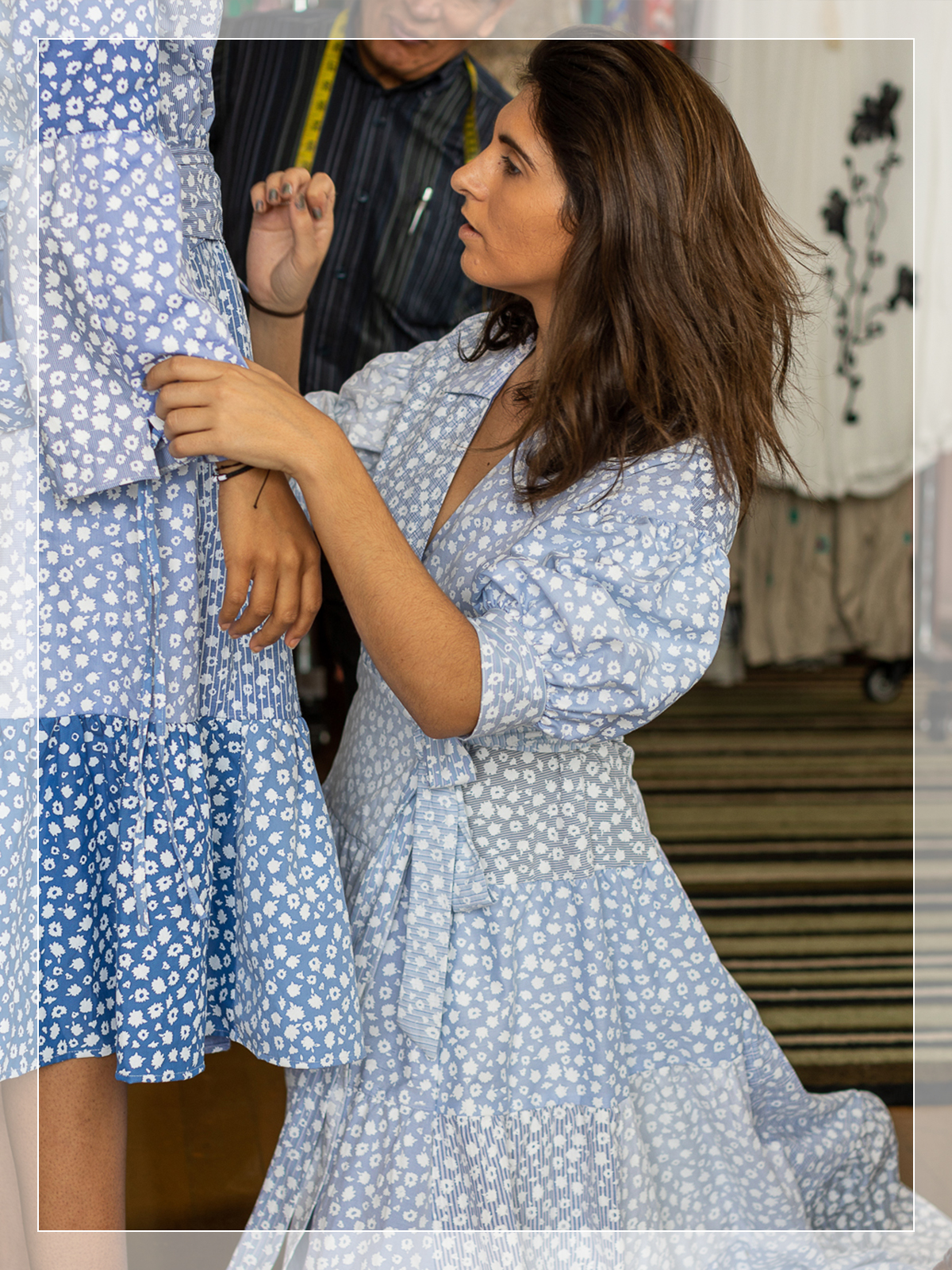
How did you break into the fashion industry, and what compelled you to found Loti?
Lottie Bertello: I'm one of those people who's always known they wanted to work in fashion, so I went to school for fashion and textile design at the Savannah College of Art and Design. After graduating, I moved to Los Angeles, where I worked as a designer at Vince, Other Stories and Paige. During quarantine, I had enough time and space to think about how I wanted to structure my career to be more aligned with issues I care about. By constantly going to second-hand shops for work, I became hyper-aware of the massive volumes of clothing being thrown away. This led me to look into upcycling to directly fight textile waste, which is the purpose of Loti at its core.
What's one fact about textile production's impact on the environment that you think surprises most consumers?
LB: I think consumers are always surprised when they learn how extensive the supply chain is regarding how many people are involved in making an item. The term "handmade” gets thrown around a lot when it comes to clothes, and most if not all garments are technically made by hand. We currently don't have machines that can operate themselves, so all clothing—no matter what brand is making it—is somewhat handmade. Once people learn this information, it's easier to understand that brands can only sell clothing at low prices by cutting corners regarding worker wages and worker rights, which both the sustainable and ethical movements are trying to shed light on.
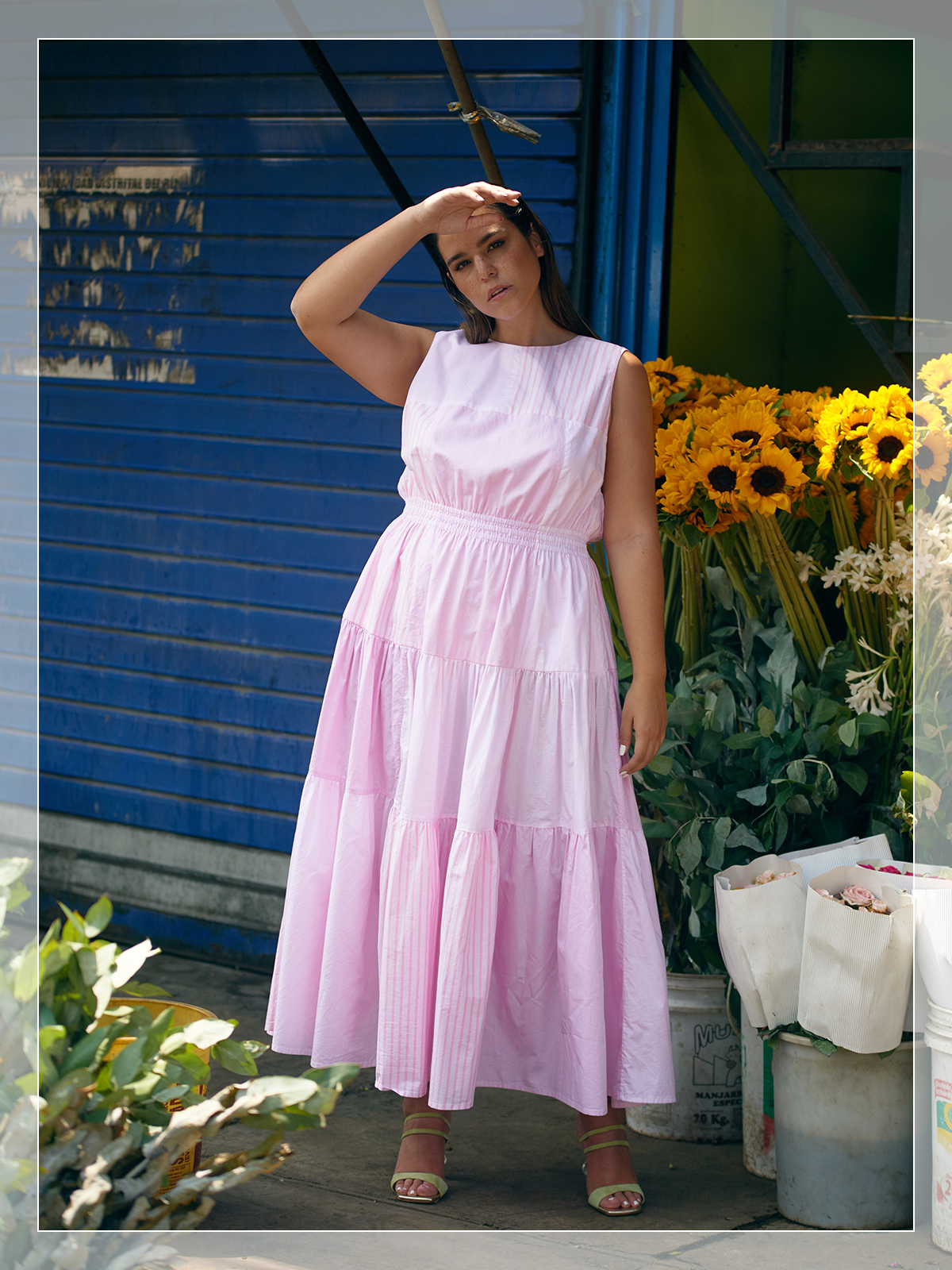
Why is revolutionizing the way we produce textiles important?
LB: As the fashion industry exponentially grows, the textile industry follows. The demand to create items for massive, fast fashion brands has skyrocketed in the last 5 years; textile factories produce more cheap, synthetic fabrics to meet these demands. In the previous 20 years, the amount of clothing the average American throws away per year has doubled, which directly correlates to the rise of these fast fashion giants. It's not just the environment that suffers from so much waste being produced, but the people who make them are under a lot more pressure to perform under the already dire conditions they are already working under. It's a vicious cycle that thrives under capitalism.
With your expertise, how would you define what a sustainable fabric is?
LB: To me, a sustainable fabric is ethically made, does not abuse our nonrenewable natural resources, and has a low impact at the end of its life. Natural fiber or eco-friendly textiles are sumptuous in theory, but if the people making them are being exploited, what's the point in advocating for them?
How is Loti applying sustainable textile production practices to its collections?
LB: Loti is an upcycling design studio, so textile waste reduction is at the core of everything we make. In the past year, I’ve expanded my definition of what Upcycling can be, and we’ve been able to find creative ways to Upcycle more textiles. For example, we’ve recently partnered with a few factories in Lima to reuse their textile waste which comes in the form of production scraps, leftover fabric, and small deadstock rolls. We continue to explore directly upcycling from ready-made clothing with our silk items, made from discarded men’s ties.
What’s one fabric you always recommend consumers avoid, and which one would you replace it with?
LB: Viscose! It’s one of the go-to fabrics for most mid to massive fashion brands because it drapes nicely on the body, prints well (the fabric holds pigment well), and is very cheap. Viscose is a semi-synthetic fabric, and although it is not made directly from plastic (it’s made from cellulose) and is technically biodegradable, it needs to go through many problematic chemical processes to be made that is incredibly harmful to the workers in these factories. According to Treehugger, "Inhaling small doses of carbon disulfide, one of the main chemicals used for its making, can cause nightmares, sleep disturbance, irritability, and memory disturbance, as well as peripheral neuropathy, parkinsonism, and retinopathy, to anyone exposed to it for long periods of time.” In addition to being harmful to produce, viscose is also a fabric that quickly loses shape after a few washes, making the garments made from lower quality and more disposable. Lyocell is currently the greener alternative that you should look for when shopping.
What are your hopes for the future of sustainability in fashion? And what role do you hope Loti plays in shaping the industry’s impact on the environment?
LB: Part of our mission is to create space for more people to feel they can participate in the Upcycling Revolution. Upcycled clothes have (for the most part) been more "out there” in terms of design, and so, we are hoping to make clothes that a different customer can feel comfortable and look great in. We want people to expand what they think can be done through upcycling and how important it is to reuse already existing materials. There are so many different areas of the fashion industry that need a complete redesign. So I’m personally hoping to see more emerging brands take on these issues in creative and disruptive ways—I think the world is finally ready for it!

At some point, you may have unknowingly spotted the work of RVN. The brand first blew up with the fashion set in 2013 when Beyoncé was spotted donning a pair of the brand’s infamous knitted leggings at the Super Bowl. You may not have known about this brand because after finding such a viral success early on, founder and designer Ted Kim took a hiatus to retool the brand. And in 2021, he relaunched RVN as an expansion beyond activewear into luxury ready-to-wear pieces. But what makes this brand truly special is in the stitching. Every piece (and we mean every single one) is made from recycled yarn woven by the equivalent of 3D printers. RVN’s fusion of sustainability, technology, and knitwear is changing the industry one garment at a time. Ahead, we spoke with the founder about his work, the importance of sustainable garment production, and what role technology plays in cutting the ecological impacts of the fashion industry.
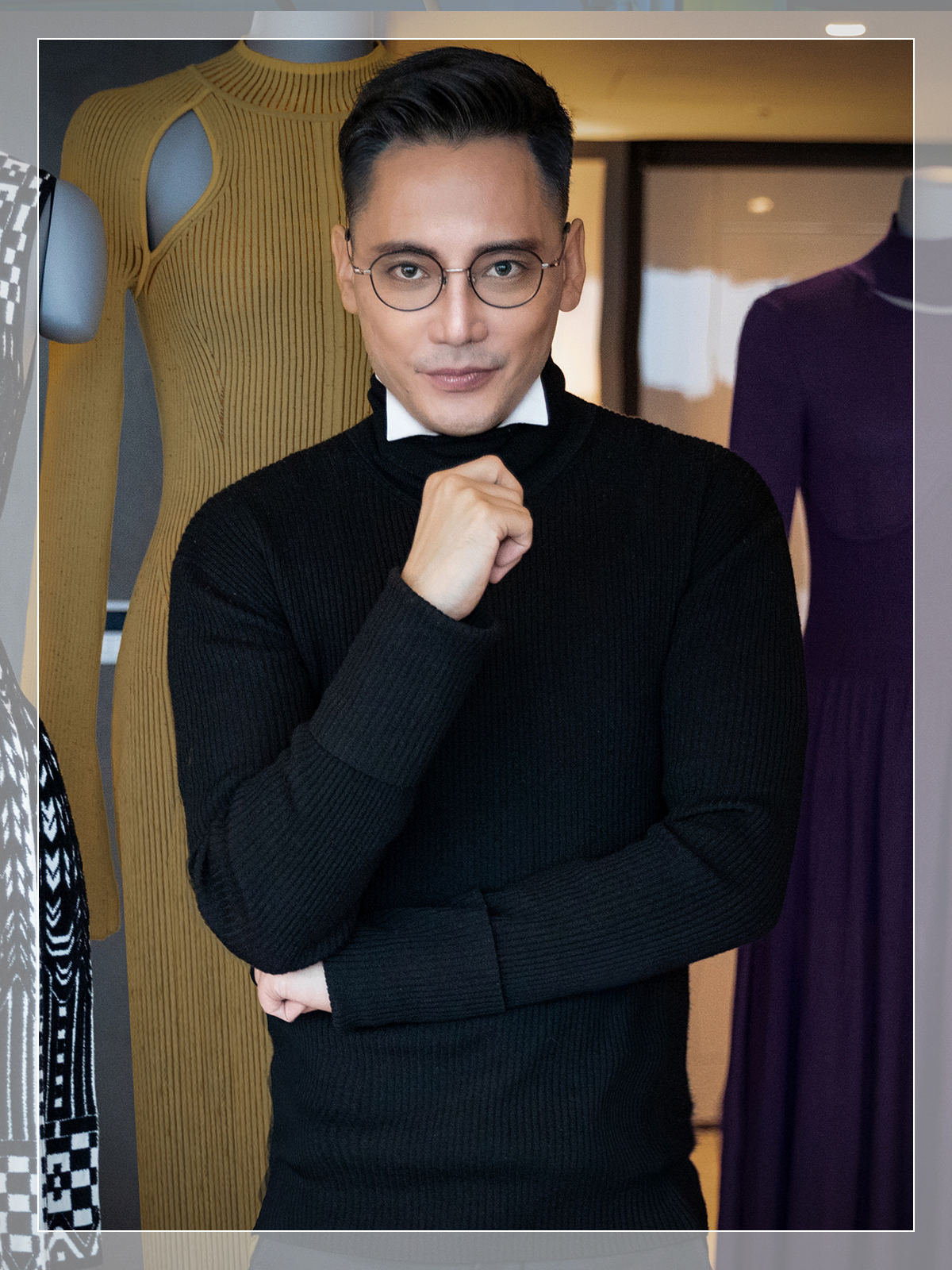
How did you break into the fashion industry, and what compelled you to found RVN?
Ted Kim: I was discovered by Donna Karan when I was a student at Parsons. I started working for her part-time while still attending Parsons and transitioned into full-time after graduation. After working for two quintessential American luxury sportswear brands (Donna Karen and Michael Kors), I was compelled to carry on a torch and start a brand that brings American luxury sportswear to the next generation, and thus RVN was born. RVN is an Acronym for revolutions. For me, the United States is the land of revolution, innovations, and dreams, and through RVN, I want to bring that to life through sustainably sourced tech-forward pieces all made from knitwear.
What's one fact about textile production's impact on the environment that you think surprises most consumers?
TK: Whenever we think about the impact on the environment, we automatically think of air pollution. However, what surprises most the customers is that the textile industry has one of the most detrimental effects on the environment through water pollution via dyeing and finishing products, toxic gas emissions, and waste in landfills. This real issue needs to be acknowledged, and sustainable principles need to be implemented throughout all stages, from design to production, all the way to the consumer.
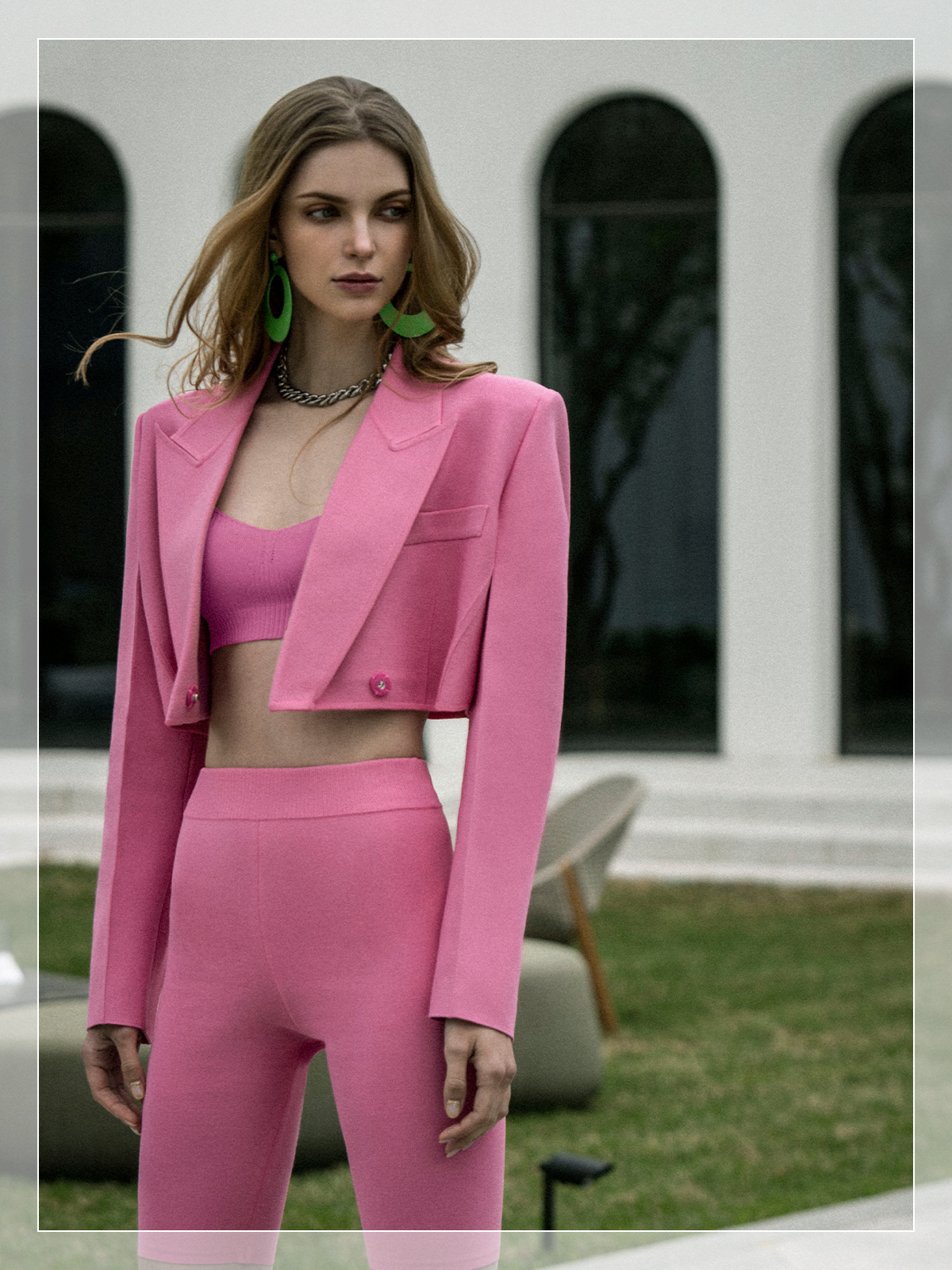
With your expertise, how would you define what a sustainable fabric is?
TK: Sustainable fabric, in our case, yarn, is either made of recycled materials or comes from eco-friendly resources, like sustainably grown fiber crops. How yarn is knitted and becomes a garment also defines sustainability, which is why at RVN, we’re championing the use of technology to eliminate textile waste.
Why is revolutionizing the way we produce textiles important?
TK: The fashion industry is the second-largest polluter globally, just after the oil industry. What’s more, 85% of all textiles go to the dump each year. And the environmental damage is increasing as the industry grows, so it’s more imperative than ever for fashion brands to step into the future.
How is RVN applying sustainable textile production practices to its knitwear collections?
TK: The main yarn used for most of the RVN collection is made with 83% recycled materials certified by the global recycled standard. Approximately 15% of woven textiles intended for clothing ends up on the cutting room floor; however, RVN through using zero-waste technology using 3D knitting machines. Garment construction is engineered into each piece of clothing before being knitted by machines (similar practice to 3D printing), thus minimizing cutting the fabrics and the wastage that comes from producing a garment by hand.
What’s one fabric you always recommend consumers avoid, and which one would you replace it with?
TK: There isn’t any particular fabric I would recommend avoiding; just keep in mind to search for clothing made in countries with stricter environmental regulations for factories. And to choose organic fibers and natural fibers that do not require toxic chemicals to be produced.
Besides checking the label to ensure consumers are buying more eco-friendly fabrics, what tips would you give to consuming more mindfully?
TK: The drop in garment prices over the last 20 years has allowed us to buy more and more clothes. We now have five times more clothes than our grandparents had. In reality, this continuous accumulation of cheap garments is only possible because of a constant reduction in production costs. This, in turn, has serious consequences on our health, our planet, and garment workers’ lives. Therefore, the most important thing you can do to be more mindful is to buy less, buy better quality pieces and recycle better.
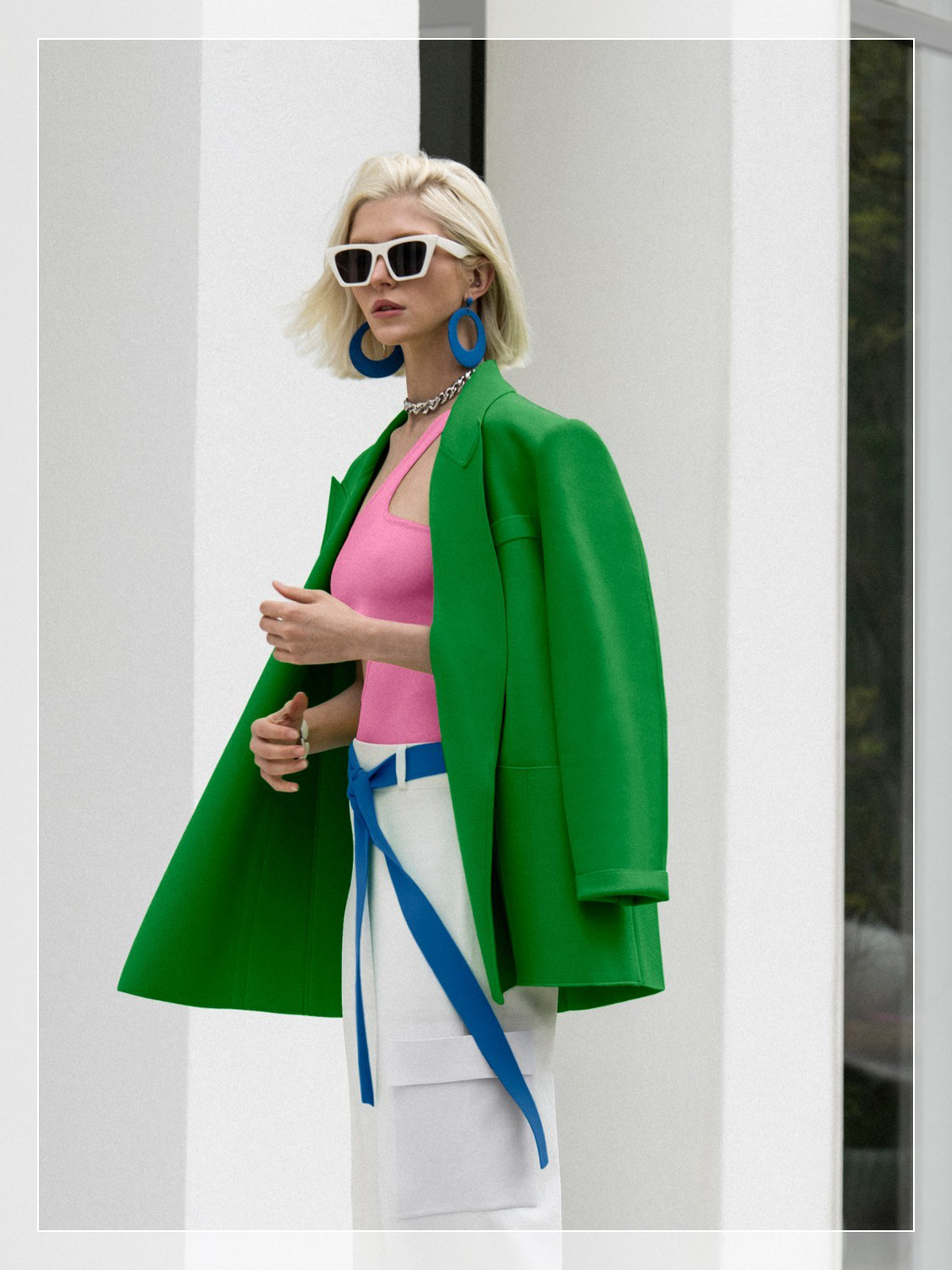
What are your hopes for the future of sustainability in fashion? And what role do you hope RVN plays in shaping the industry’s impact on the environment?
TK: We hope to become a role model and leader of sustainable fashion through our constant sourcing of sustainable materials in every facet of garment manufacturing—from raw materials all the way to packaging. And through our innovative garment manufacturing process, we reduce waste using 3D knitting technology. We want everyone to join in on the revolution, and if we can help make it easier for other brands to adopt more sustainable production practices. That’s what makes this work meaningful.
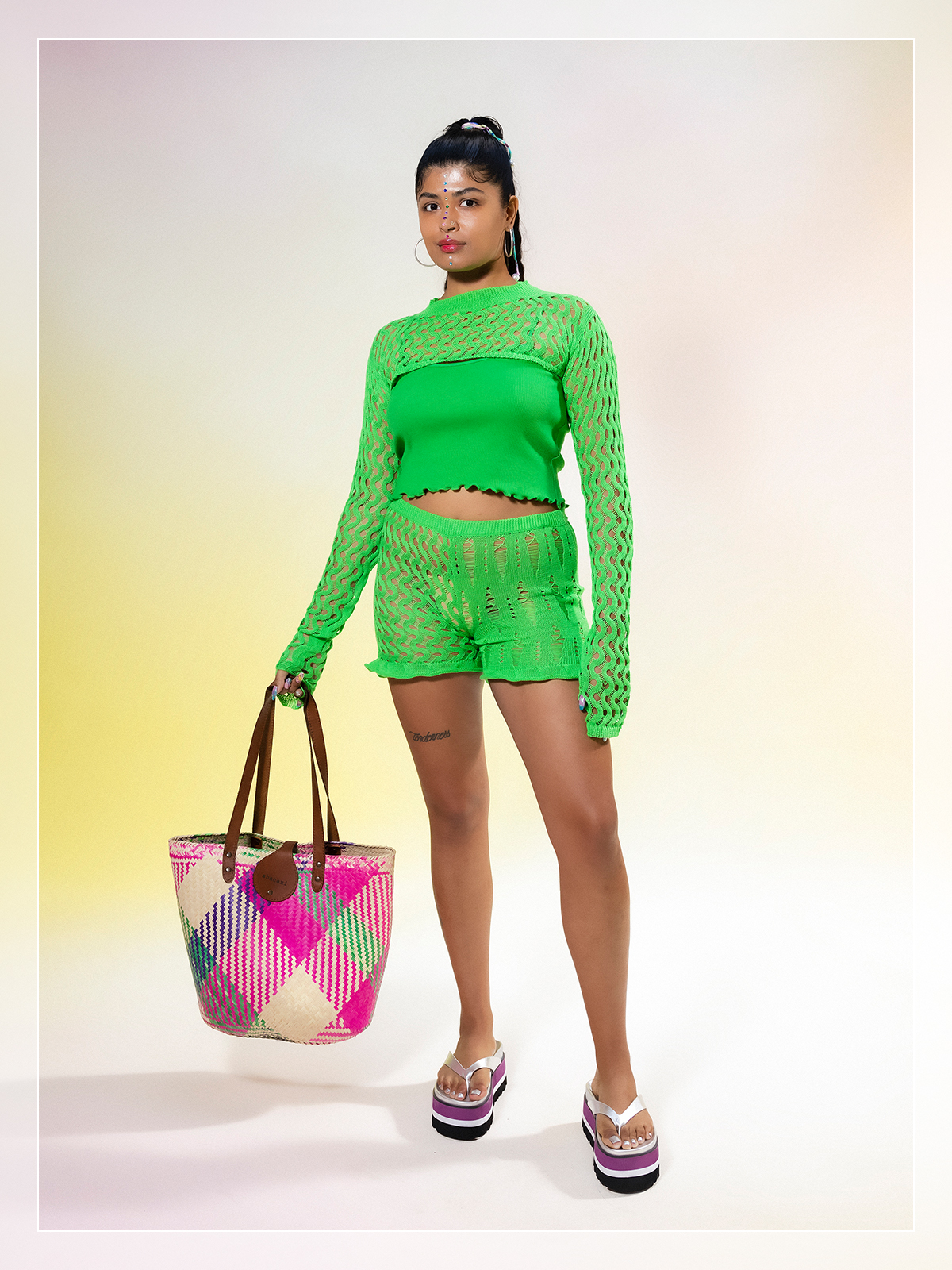
How we shop compared to previous generations has altered dramatically, and with that, so has how we produce clothing. Before the ’80s, most clothing was made often by artisans and on a seasonal basis; in many ways, the shift to weekly drops has diminished the value and art of well-made clothing. But the Brooklyn-based brand Abacaxi is trying to bring that back. Woven into the bedrock of this brand is the championing of South Asian textile techniques, ethical fabric dying practices, and the sourcing of sustainable materials that create ready-to-wear pieces that speak to the richness of the founder’s heritage and the beauty of producing clothing mindfully. These reasons (and many more) compelled us to speak with the founder and designer behind the brand, and ahead, you’ll hear from Sheena Sood herself about her dedication to championing sustainability one piece at a time.
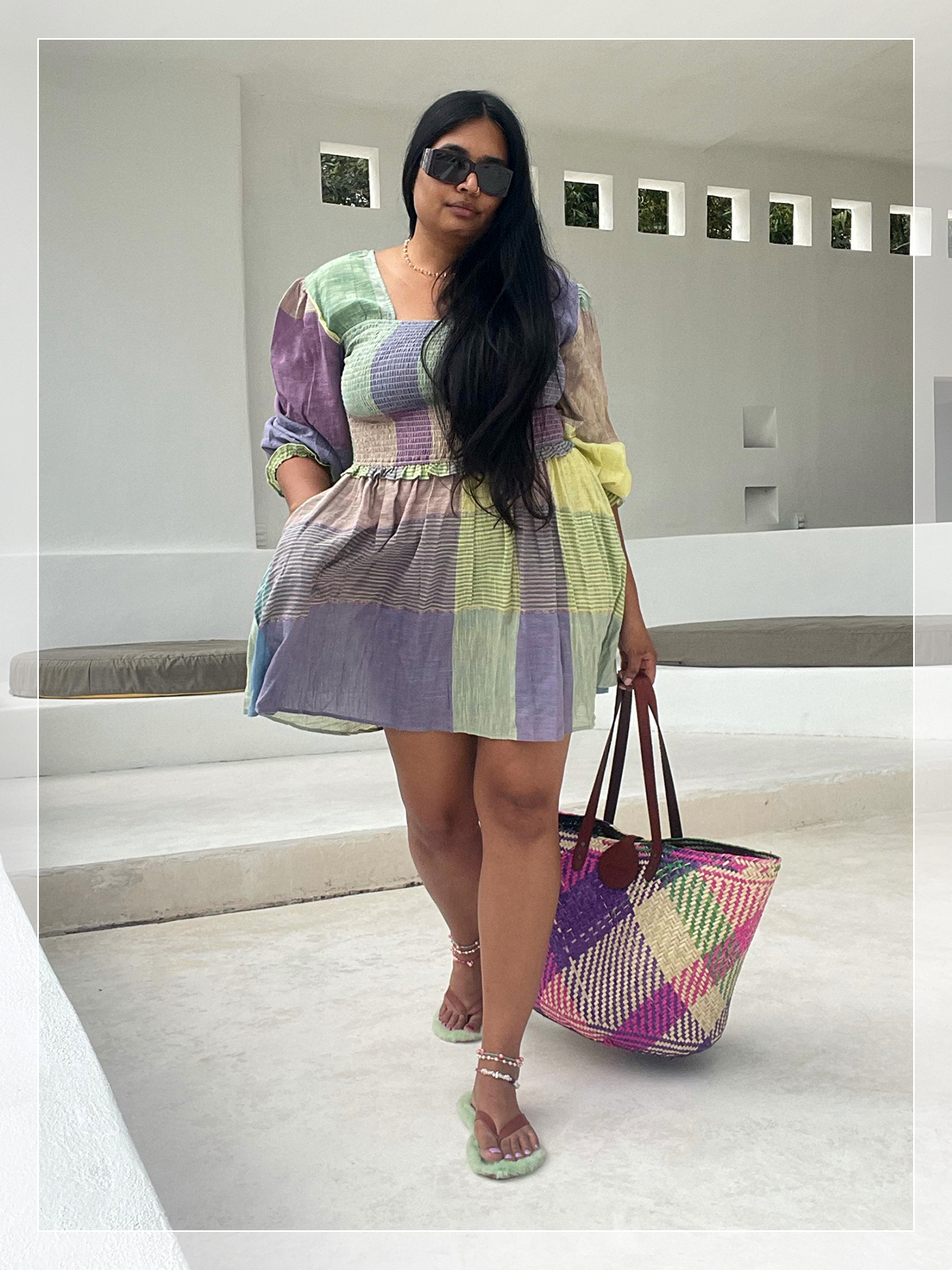
How did you break into the fashion industry, and what compelled you to found Abacaxi?
Sheena Sood: I started Abacaxi because I wanted to work with so many different traditional Indian handmade and handloom textile techniques, many of which are at risk of disappearing into contemporary fashion and back into our everyday. I was always fascinated by the breadth of different embroideries, types of weaves, and intricate forms of beading that were possible in India, and it remains one of the main points of inspiration in my work today. There are so many regional and local heritage processes that I want to explore; even after designing several collections over the years now, I feel I am just getting started and scratching the surface. The kaleidoscope of possibilities there is so rich.
What’s one fact about textile production’s impact on the environment that you think surprises most consumers?
SS: Actually, I often like to mention beyond the impact of textile production on the environment because we don’t think as much about a textile’s effect on our own body. Just as it matters what we eat and put in our bodies, the energy and quality of the fabric we put around our bodies make a difference to our health and outlook.
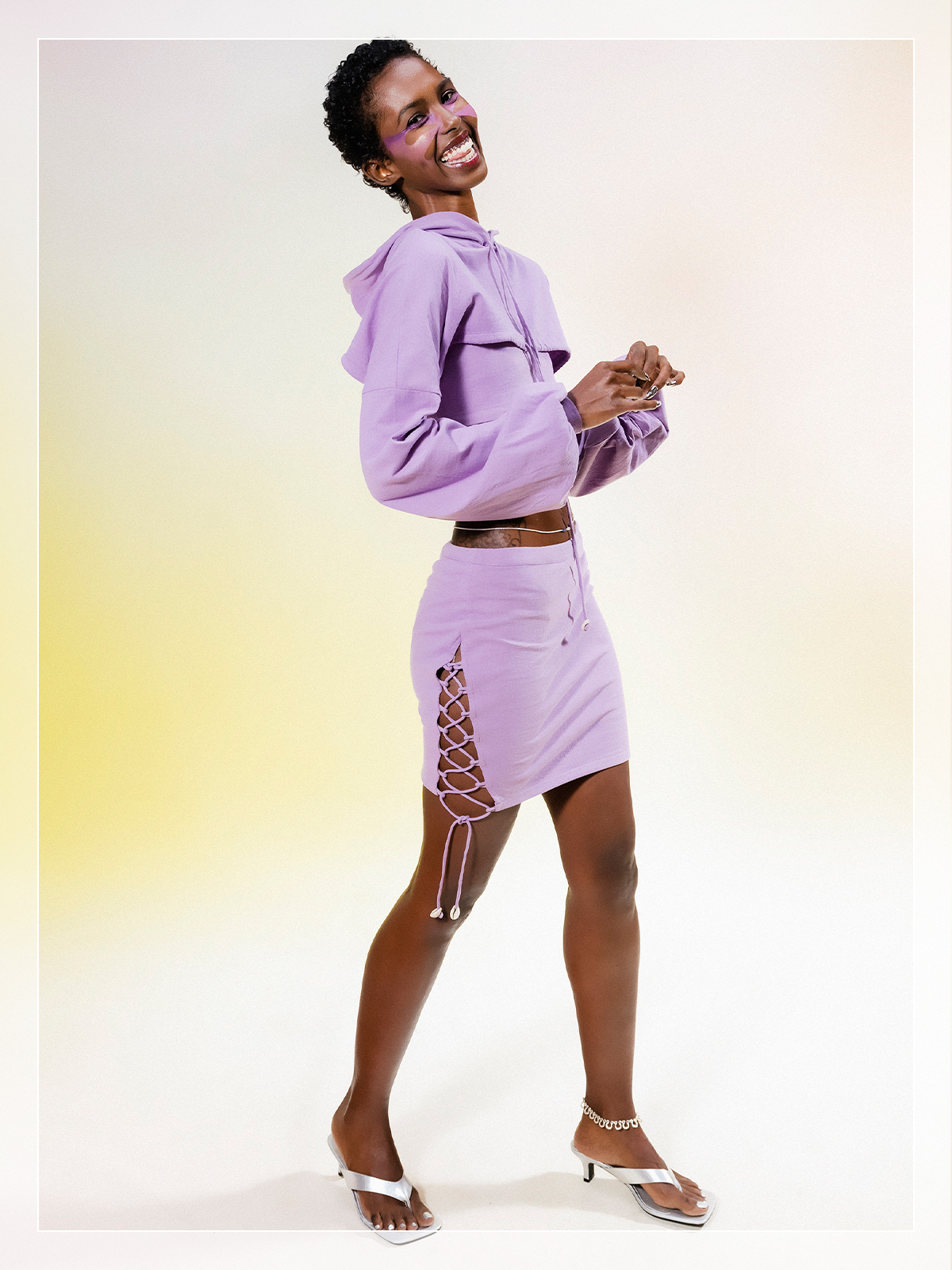
With your expertise, how would you define what a sustainable fabric is?
SS: I would say that a sustainable fabric is made without toxic chemical waste and when all of the makers have been paid and treated fairly.
Why is revolutionizing the way we produce textiles important?
SS: The amount of waste and toxins caused by textile production is so significant, and given the current state of the climate crisis, it is critical to change the way things are being done. There are many more sustainable and indigenous ways of creating and making that can be incorporated into our textile productions.
How is Abacaxi applying sustainable textile production practices to its own collections?
SS: We have always been mindful of fabric choices and sustainability, as the emphasis on traditional textiles, ethical production, and natural fibers has been there from the beginning. We are now partnering with Oshadi in India to use 100% organic regenerative cotton in our future productions. I just visited the farm, weavers, natural dyer, and factory there and am so happy to be working with them. It was incredible to see the holistic way everything is done and the way that ancient Indian practices for both farming and textile development are being used there. And we just launched a new website for abacaxi. Now you can explore each of these traditional textile techniques, see videos and photos of the processes, meet the makers, and even shop by technique or collection concept. We have a section for naturally dyed pieces, handloom woven fabrics, and for our Peruvian knits and crochet. All purchases directly support the artisan makers.
What’s one fabric you always recommend consumers avoid, and which one would you replace it with?
SS: Personally, I have a hard time wearing polyester because it doesn’t let the skin breathe. I avoid it myself, but if you like the way polyester feels and travels or want to incorporate it, there are 100% recycled poly-fibers and so much vintage or existing material that you can shop.
Besides checking the label to ensure that consumers are buying more eco-friendly fabrics, what tips would you give to consuming more mindfully?
SS: Try only buying new pieces that will last in your wardrobe, quality ones that have multiple uses, or that you see yourself wearing for years to come. There is no need to reinvent your wardrobe every season, and I always try to remind my customers about that. I design with that in mind so that my collections flow together a bit from season to season so that it’s easy to mix pieces from one season with past ones.
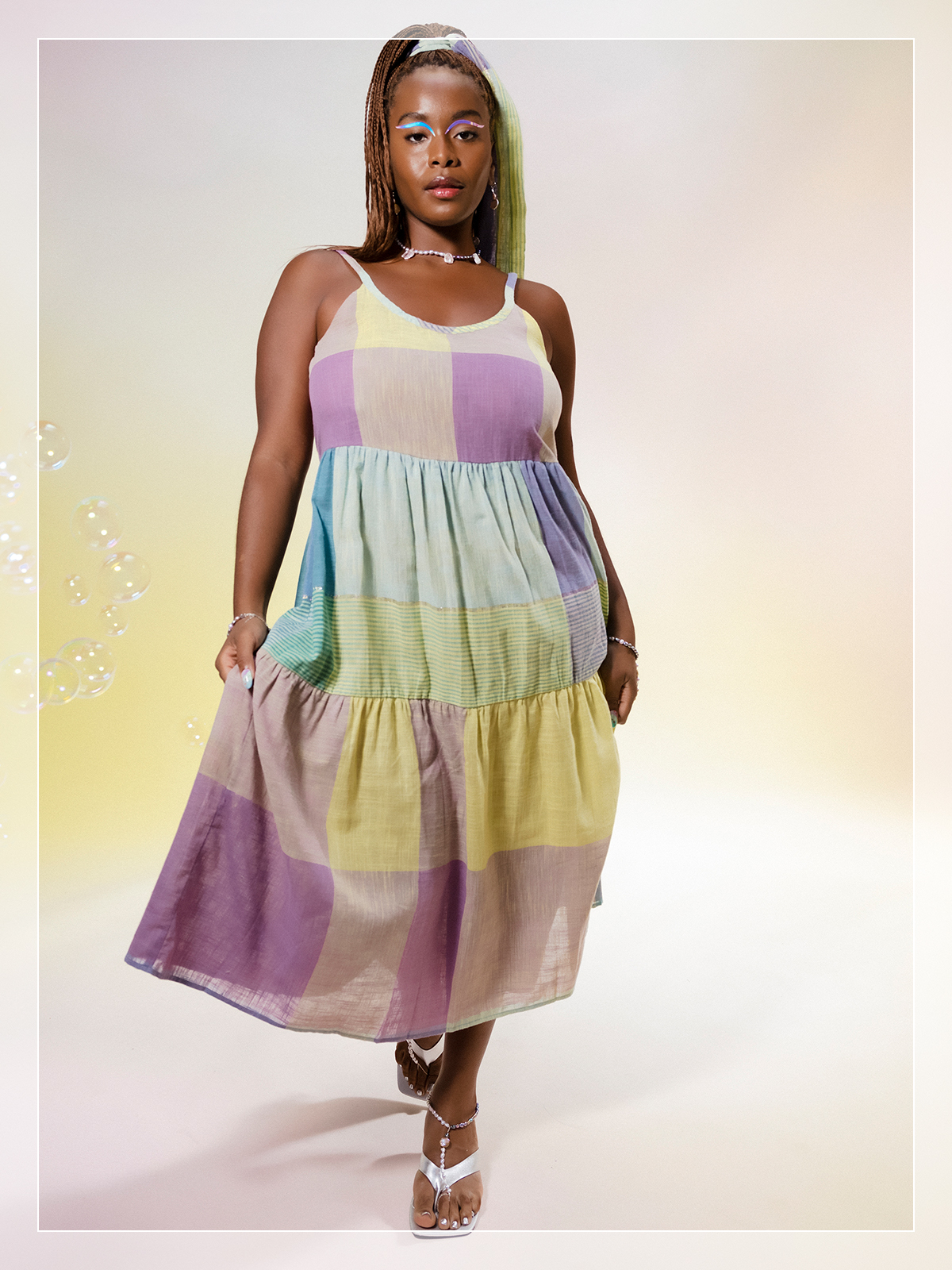
What are your hopes for the future of sustainability in fashion? And what role do you hope abacaxi plays in shaping the industry’s impact on the environment?
SS: I’d love to continue sharing and creating more awareness around heritage textiles from India and from different regions around the world. The wealth of possibilities in terms of designing within these ethical parameters is so exciting to me, so I hope to continue to be able to create in this way and keep expanding the brand, the scale, and the impact of what we are doing within the industry.

Combating textile waste as a fashion brand comes from deciding off the bat you’re not going to add to the problem, and that’s the decision the French duo behind La Femme Apéro made. Sarah Lequimener and Léa Enderlin co-founded the New York City based sustainable label in 2019 to create timeless pieces that not only transcend trends but were made with no newly produced textiles fabrics. Each garment is made in a female-owned factory in Istanbul, Turkey, that ensures a living wage, using GRS-certified recycled materials in sizes XS 3XL. It takes true vision to create a sustainable size-inclusive capsule label. Ahead, we spoke with both founders about what compelled them to start the brand and the importance of innovation in the long term.
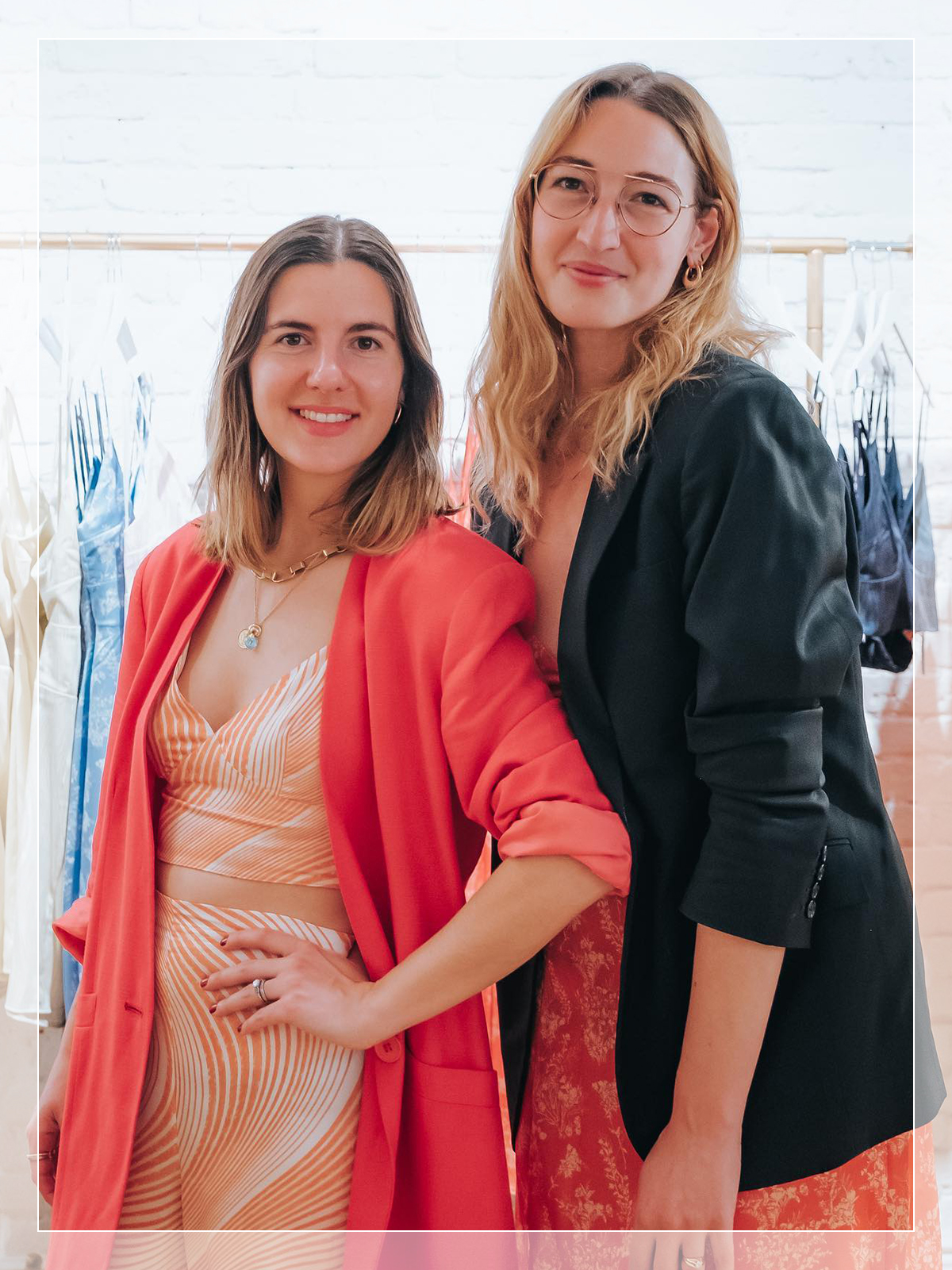
How did you break into the fashion industry, and what compelled you to found La Femme Apéro?
Sarah Lequimener: Styling for magazines and campaigns has always been a dream for me, so I studied fashion and worked for a few years in Paris before traveling to NYC. I was the first assistant of one of the best stylists in NYC, Brian Molloy, and worked with prestigious brands for several years.
Léa Enderlin: I’ve worked as a designer for over a decade, first in Paris and then in L.A. and New York. I’ve learned a lot about sourcing and manufacturing during those years and was shocked by the production practices, work conditions, and waste that I witnessed at some of the companies I worked for. Sarah and I are best friends, and after work, we would meet for an "apéro,” the French equivalent of happy hour. We���ve always wanted to work for ourselves. We decided to build a brand intentionally—focusing on ethics and eco-responsibility, an accessible but fair price point, flattering cuts for everybody, and style rather than trend-driven.
What's one fact about textile production’s impact on the environment that you think surprises most consumers?
SL: We hear a lot that the textile industry is highly polluting, but to us, there is a fact that truly puts it into perspective and surprises (or shocks) our customers when we mention it. It’s the fact that the textile industry is responsible for more global carbon emissions in a year than all the international flights and maritime shipping combined!

With your expertise, how would you define what a sustainable fabric is?
LE: To us, a sustainable fabric is a fabric that is intentionally sourced with limiting waste and pollution in mind. If made of synthetic fibers, they should be recycled and recyclable. If made from natural or regenerated natural fibers, there should be transparency about the environmental impact of making the fabric and concrete steps taken to reduce it. Upcycling and using materials created out of waste is a great option, and it’s what we are moving towards for next summer.
SL: The dream would be to work with only circular fabrics. This implies that no waste is created—all materials are either infinitely recyclable or biodegradable. The idea of circularity is fascinating; it’s something that we should all be working toward. Unfortunately, this is not yet a reality beyond small pilot projects, but it could be in the future. In the meantime, we all have to take an intentional approach to textile production and educate ourselves and our customers.
Why is revolutionizing the way we produce textiles important?
LE: There are so many different battles to fight regarding waste in the fashion industry, but we have to keep in mind that if we start at the core of the issue (fibers and how they are made), we can achieve very impactful results. There is not only one way to solve the problem of sustainability for textiles. Each fiber has a different impact, and trade-offs are inevitable. Still, ultimately, we must restructure the whole industry because textile production affects the environment, wildlife, and entire communities (through water pollution, energy usage, air pollution, and deforestation) at such an enormous scale that we can’t afford to look away.
How is La Femme Apéro applying sustainable textile production practices to its own collections?
SL: We started with the decision not to mill new fabrics. Finding ways to tackle waste and sustainability can be very intimidating for a small business. For our first year, we bought overstock, meaning that we tagged onto existing orders from other companies, buying extra fabric that was produced for them but not used. When that wasn’t possible, we focused on materials that were either 100% recycled or a blend of recycled fibers and natural fibers.
We work with mills that we know and require regular audits certifying the provenance of the threads and where and how the fabric is dyed or printed. We are thinking about ways to introduce upcycling for future seasons, and we plan to produce a capsule using deadstock fabrics each season. It’s a whole new way of designing! It requires us to be creative within what is available to us, and it’s an extra step to achieving our vision. It’s both inspiring and frustrating at times.
What’s one fabric you always recommend consumers avoid, and which one would you replace it with?
LE: In truth, it is not the type of fiber that determines its sustainability but how it is manufactured. Bamboo, for example, is very sustainable to grow but requires a lot of chemicals to break down. I would generally avoid synthetic fibers if they are not recycled and would replace them with viscose (natural fibers made from tree cellulose), modal, or lyocell since they can achieve a similar drape and weight. Tencel especially is a good option, as the company that produces it, Lenzing, adheres to strict environmental policies.
Besides checking the label to ensure that consumers are buying more eco-friendly fabrics, what tips would you give to consuming more mindfully?
SL: I think we need to change our mindset slowly—small brands and labels are working hard to deliver a more sustainable fashion. Suppose you can make a choice to buy from a small business. It will always be more sustainable than being from a big corporation because emerging brands tend to produce locally, in limited quantities, and reinvest in the local community. Being mindful also questions how many trends you truly need to consume and relearn to value quality and personal style over newness. Whenever you shop, consider the full life cycle of the garment you buy. Will you want to keep it for a long time? If not, will you be able to dispose of it sustainably?
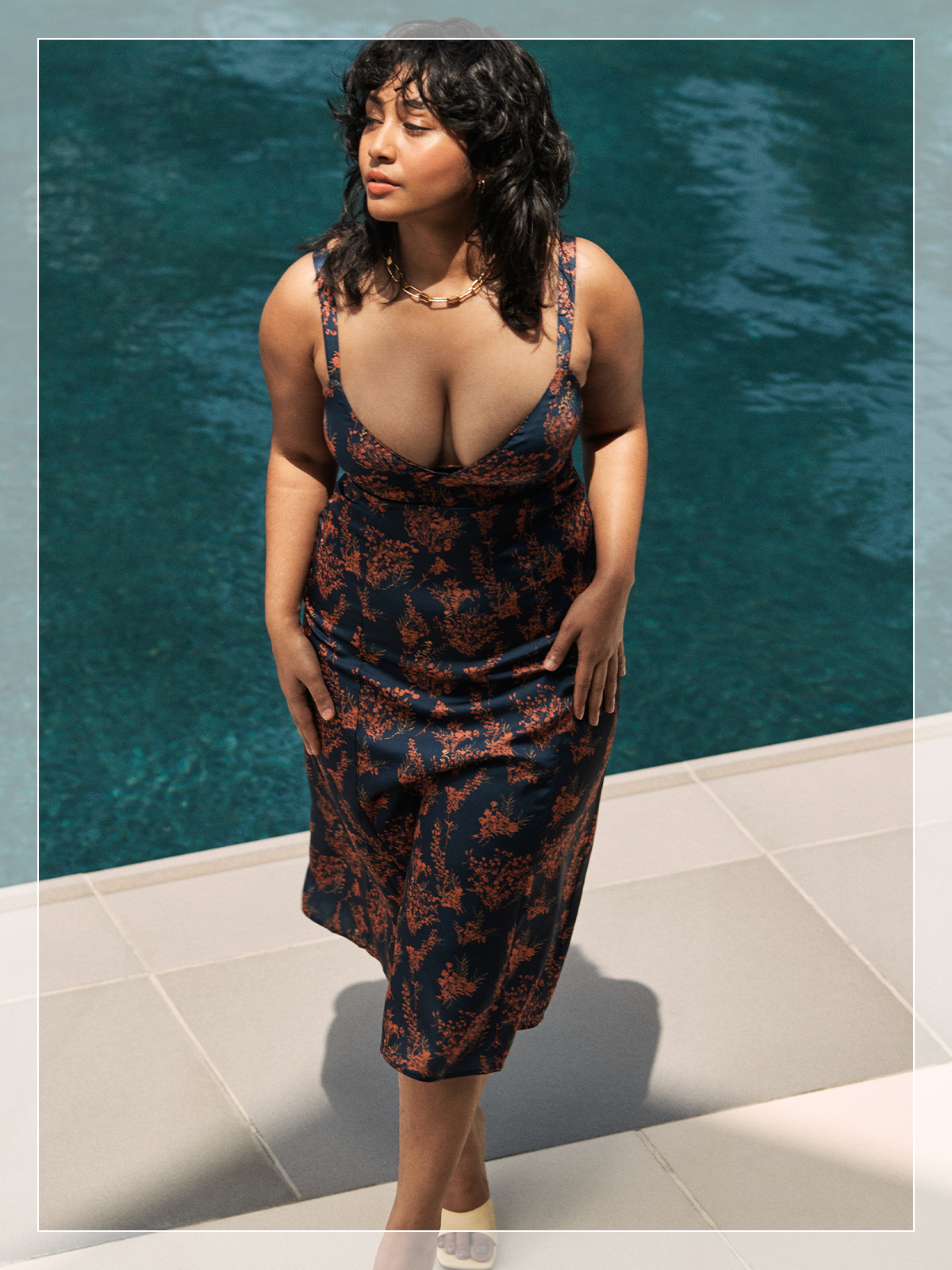
What are your hopes for the future of sustainability in fashion? And what role do you hope La Femme Apéro plays in shaping the industry’s impact on the environment?
LE: We really hope big corporations and luxury houses will continue to strive toward sustainable practices (for some) or invest in developing innovative fibers to limit toxic waste and embrace change towards safer work conditions. Some solutions already exist, and it is imperative for big companies to put their money where their mouth is and to start utilizing all available options until sustainable practices are the industry standard. As for La Femme Apéro, we think an open dialogue is essential to educate consumers because they are a massive force for change! We will keep talking openly about our process and our point of view on sustainability both to our customers and to our community.
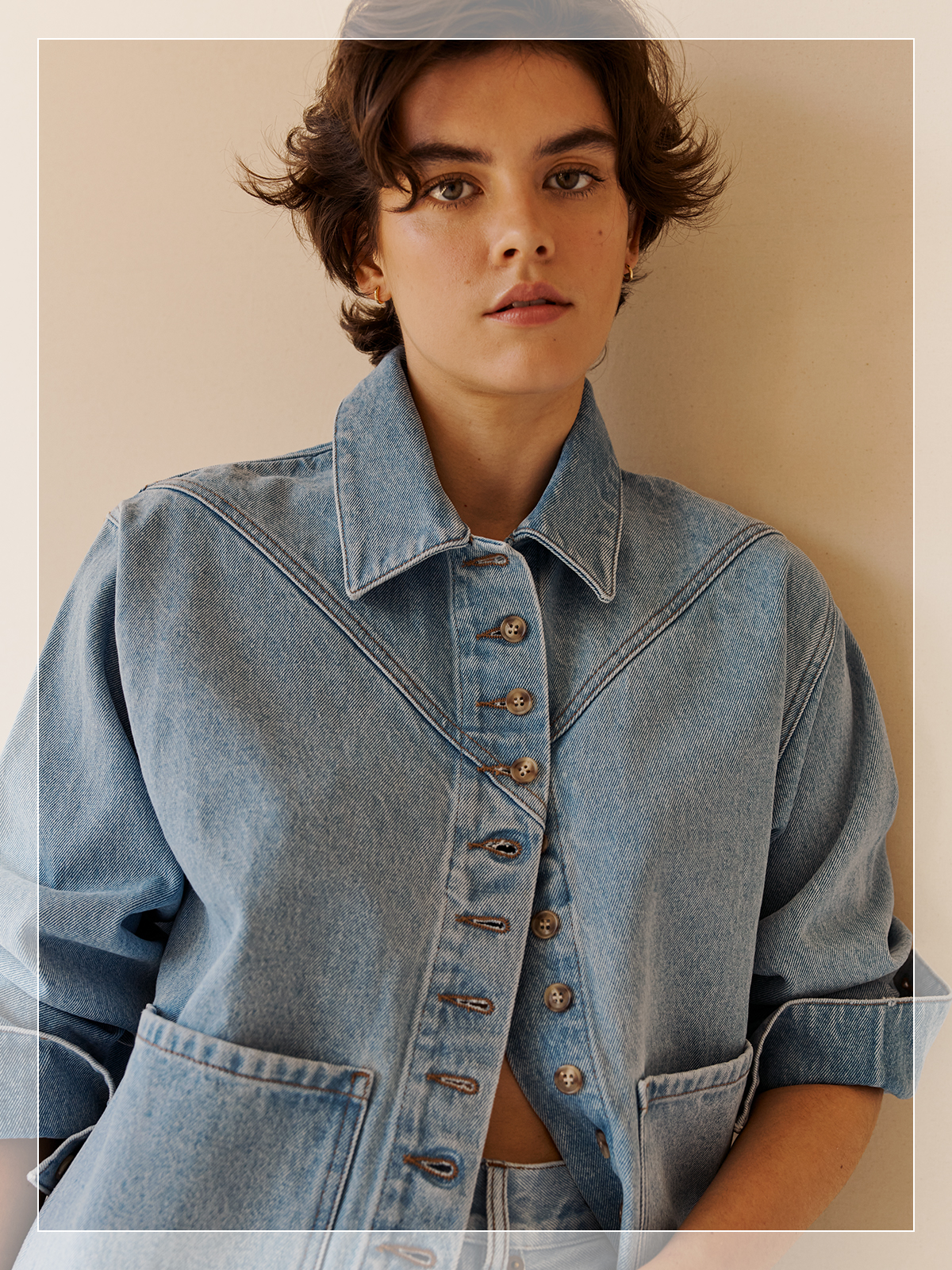
If you’ve made it to this point, you’ve hopefully come to the realization that some of the worst fabrics for the environment are non-biodegradable (we’re looking at polyester and acrylic). But there is also a slew of other materials that use an extreme amount of resources to produce the textile: Nylon uses crude oil, rayon uses toxic chemicals, and most polyurethane fabrics (known as vegan leather) are made from plastic and crude oil. But possibly the most surprising material that has the most significant impact on the environment is denim. A typical pair of jeans uses the same amount of water that one person drinks in 13 years—and we’re not even talking about the toxic dyes used to get that signature hue.
Making sustainable denim is a challenge in and of itself, but it’s something that the denim brand, Still Here aims to do. Co-founded by Sonia Mosseri and Maurice Mosseri, the brand champions cutting the impact of textile production down, and they’ve created a closed-loop production line that’s changing the way we think about denim. Ahead, you’ll hear from the couple about the importance of sustainable denim.
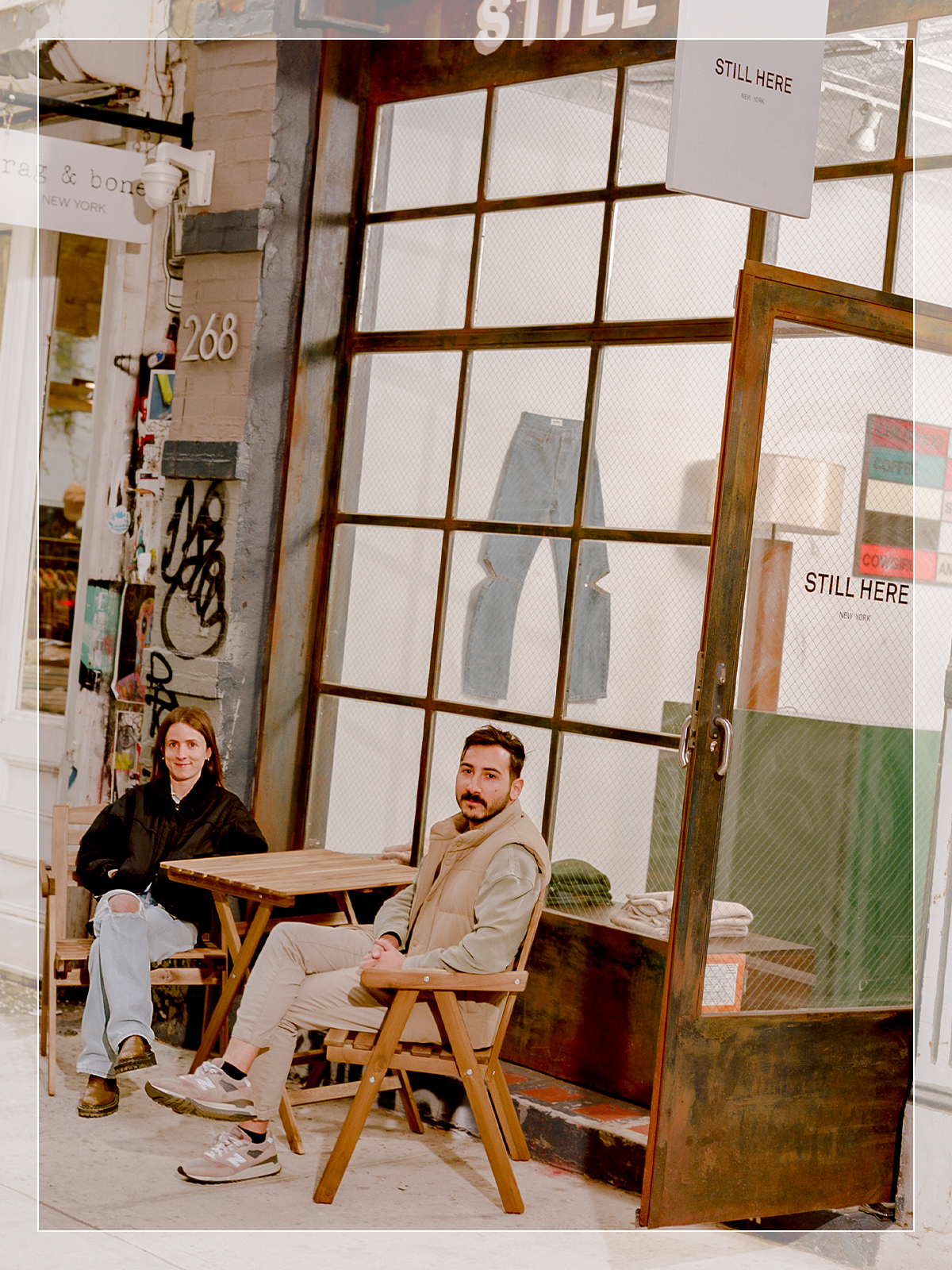
How did you break into the fashion industry, and what compelled you to found Still Here Denim?
Sonia Mosseri: My dad immigrated to the USA from Egypt when he was young. His parents gave him a few dollars to buy jeans that would last him many years—he bought Levi's that did, in fact, last him many years. When he got older and had kids, he gave those jeans to me: filled with patches sewn by my grandmother and ink stains from College. Those jeans began my love for vintage jeans, and I began collecting them. After College, I started to paint stripes on these jeans and got some attention online. I was eventually invited to the Capsule show in NYC to paint on vintage jeans, and by the end of the three days, I had over 150+ interesting boutiques and retailers who wanted to carry the product.
A week later, Barney's emailed us for line sheets. That was sort of our aha moment, where we decided to take the year and dive into launching a denim brand based on what we felt was missing from the market. One year later, we responded to the email and were able to launch our first line with Barney's New York. Later that year, we launched with Net-a-Porter, Bergdorf Goodman, and others. It's been a fun journey ever since.
What's one fact about textile production's impact on the environment that you think surprises most consumers?
SM: People don't recognize the actual life-cycle of clothing. Where does it go after you get rid of it? Fast fashion has impacted our relationship with clothing and how much extra clothing is actually in the world right now. There is such an incredible amount of waste that's shipped off to other countries from the U.S. These countries often don't have the capability to sort or upcycle the volume being imported. So much of that waste just end up in landfills, and it's heartbreaking.
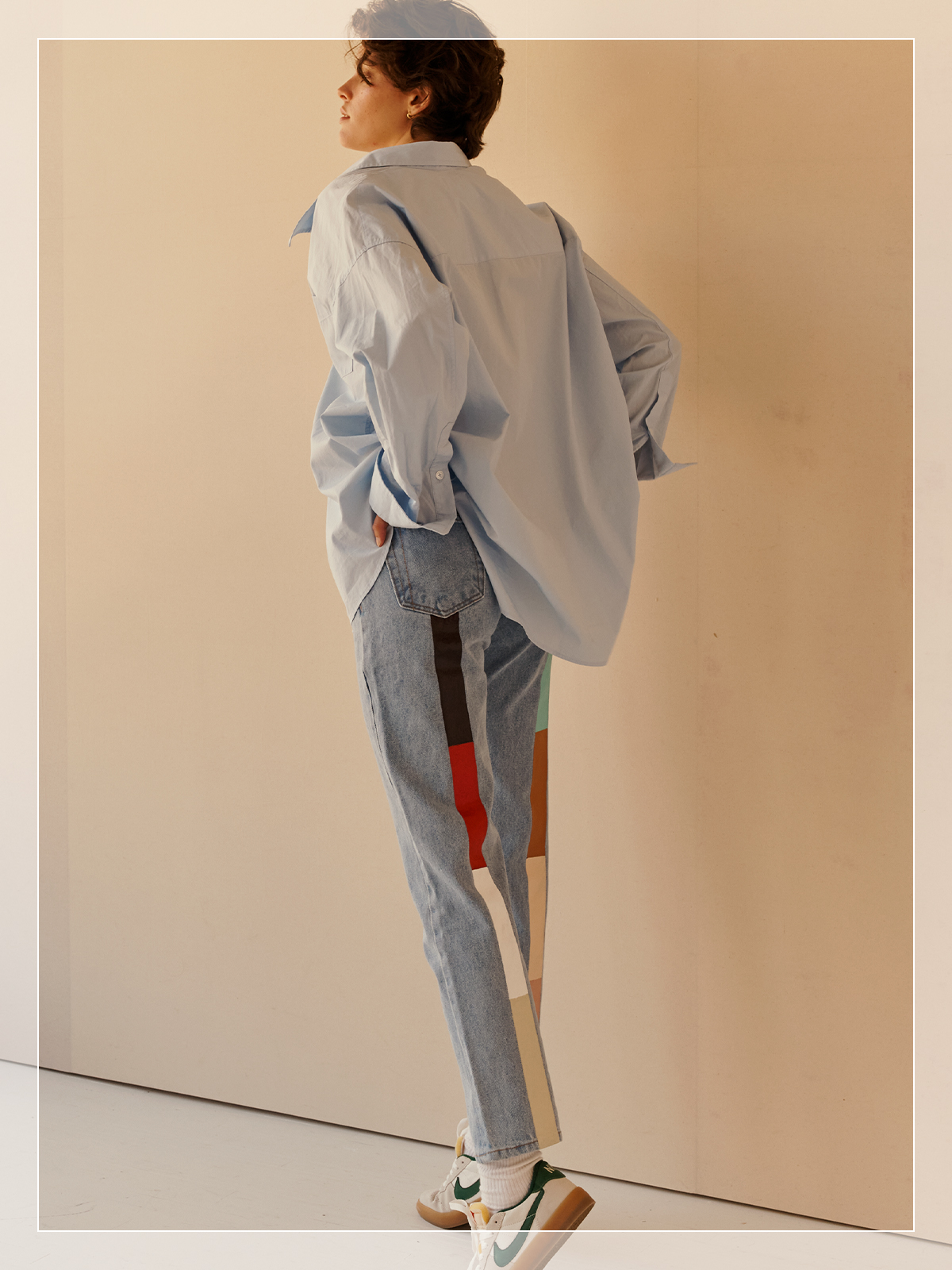
With your expertise, how would you define what a sustainable fabric is?
SM: I’m still learning, but I think using materials that aren't harmful to the earth in production or post-production makes something sustainable. Unfortunately, it's challenging to make denim sustainably, but there are ways to control or minimize the bad. Working with upcycled biodegradable materials is a great step in the right direction. Our Bone jeans are the most eco-conscious of our line. They are made with an astonishing fabric from the New Denim Project, which is just that: 80% upcycled denim and 20% Organic Cotton.
Why is revolutionizing the way we produce textiles important?
Maurice Mosseri: Textiles production is a multi-billion dollar industry. It's never going away. I think we can collectively make a difference by shifting our values around clothing. For starters, the life cycle of a garment should be much longer than we are now used to. This will naturally slow fash-fashion purchasing and, of course, production at the textile level. Spending more money on well-made garments will benefit everyone in the long run because they'll last longer and save the planet and your wallet long-term. And if that garment is made of biodegradable materials, they can dispose of it knowing it's not toxic to our earth. These principles are not yet well taught or understood. If we don't actively work to revolutionize the industries hurting our environment, we are doing ourselves a disservice: constantly consuming cheaply made, poor quality products and negatively impacting the environment we live in, which lowers our quality of life.
How is Still here applying sustainable textile production practices to its own collections?
MM: The two things that we can always control are how we market our jeans. We want Still Here customers to wear their jeans for many years. Rip them. Patch them up (we're happy to help). The second is the materials we use in production. Still Here jeans are made of 100% cotton. We try to work with fabric mills that incorporate recycled materials and search for partners that align with our values. We used to work with a lot of deadstock denim, but it eventually ran out (which is the nature of dead-stock). We work with reduced water in our washing and PH-neutral chemicals. All of that still does not mean our jeans are sustainable. However, we are trying to be better and learn as much as possible as we continue to grow.
MM: We also put a lot of effort into educating consumers, especially around our coffee brand, Still Here Café. Our coffee beans are grown using the leftover waste from our denim production process. In partnership with the New Denim Project, our denim waste is upcycled into a fertilizer used to grow coffee trees in the Guatemalan Highlands. We're excited to bring this story to our audience to explain to them what a closed-loop production looks like.
What’s one fabric you always recommend consumers avoid, and which one would you replace it with?
SM: I grew up in a house where my father only believed in buying cotton and wool clothing—that's it. We were not allowed to purchase anything with polyester in it, and I'm smiling now because I didn't always appreciate this mentality, but I do now!
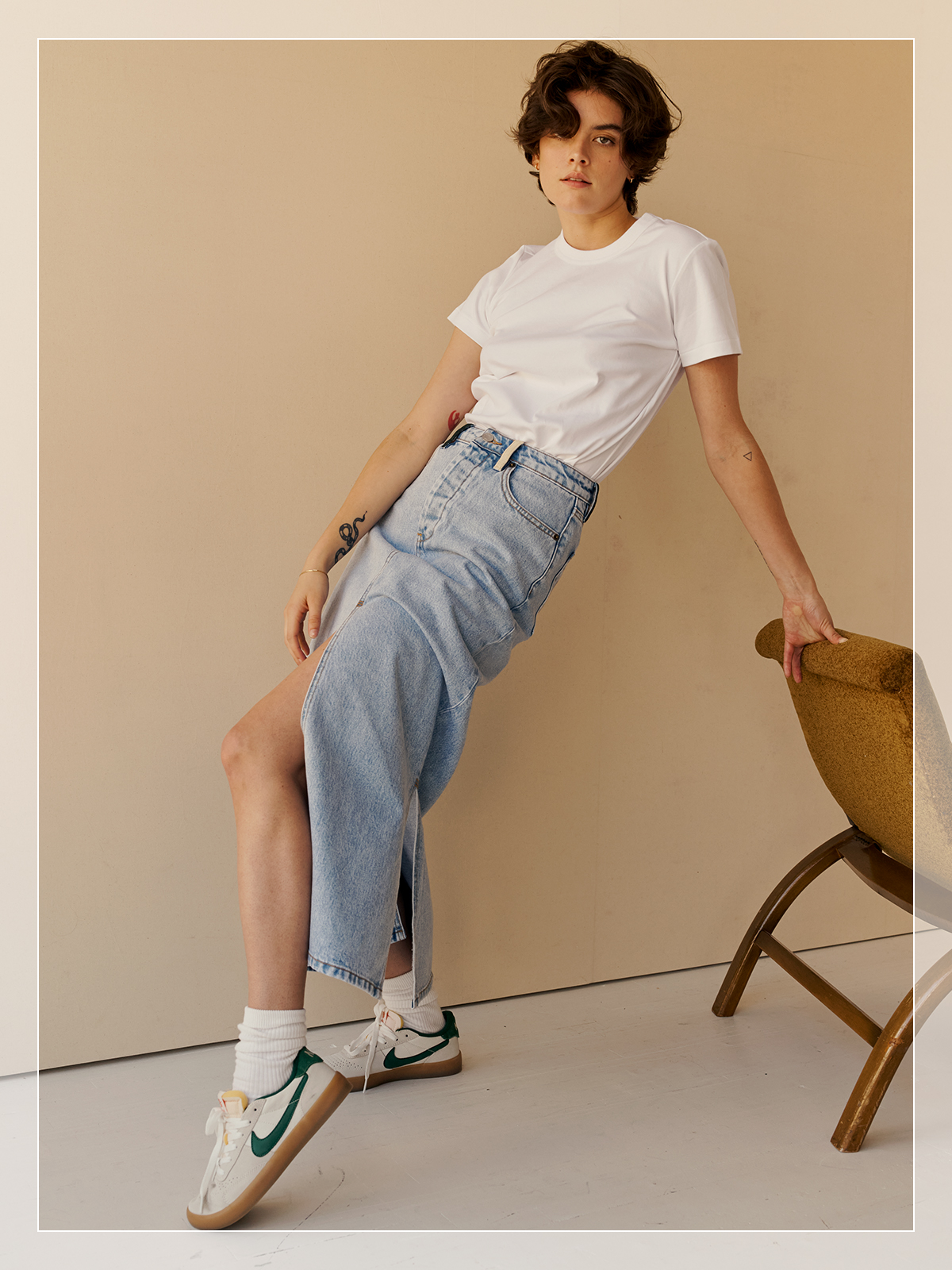
Besides checking the label to ensure that consumers are buying more eco-friendly fabrics, what tips would you give to consuming more mindfully?
MM: Buy staples that you don't see yourself getting sick of quickly. Value your purchases more.
What are your hopes for the future of sustainability in fashion? And what role do you hope Still Here plays in shaping the industry’s impact on the environment?
MM: I hope we can work with others in our industry to manufacture more responsibly collectively. I hope Still Here can be part of the solution, not the problem. We are constantly working to find creative ways to minimize waste and educate our audience in the process. It's important to us that the masses begin to understand our impact and why we're doing things like starting a coffee brand. We each individually have an impact and to inspire and influence others is our strongest ability. It's not easy to prioritize making a positive impact, but it's honest work.
Next: We Test-Drove 10 Eco-Friendly Brands—Now, We Can't Stop Talking About Them
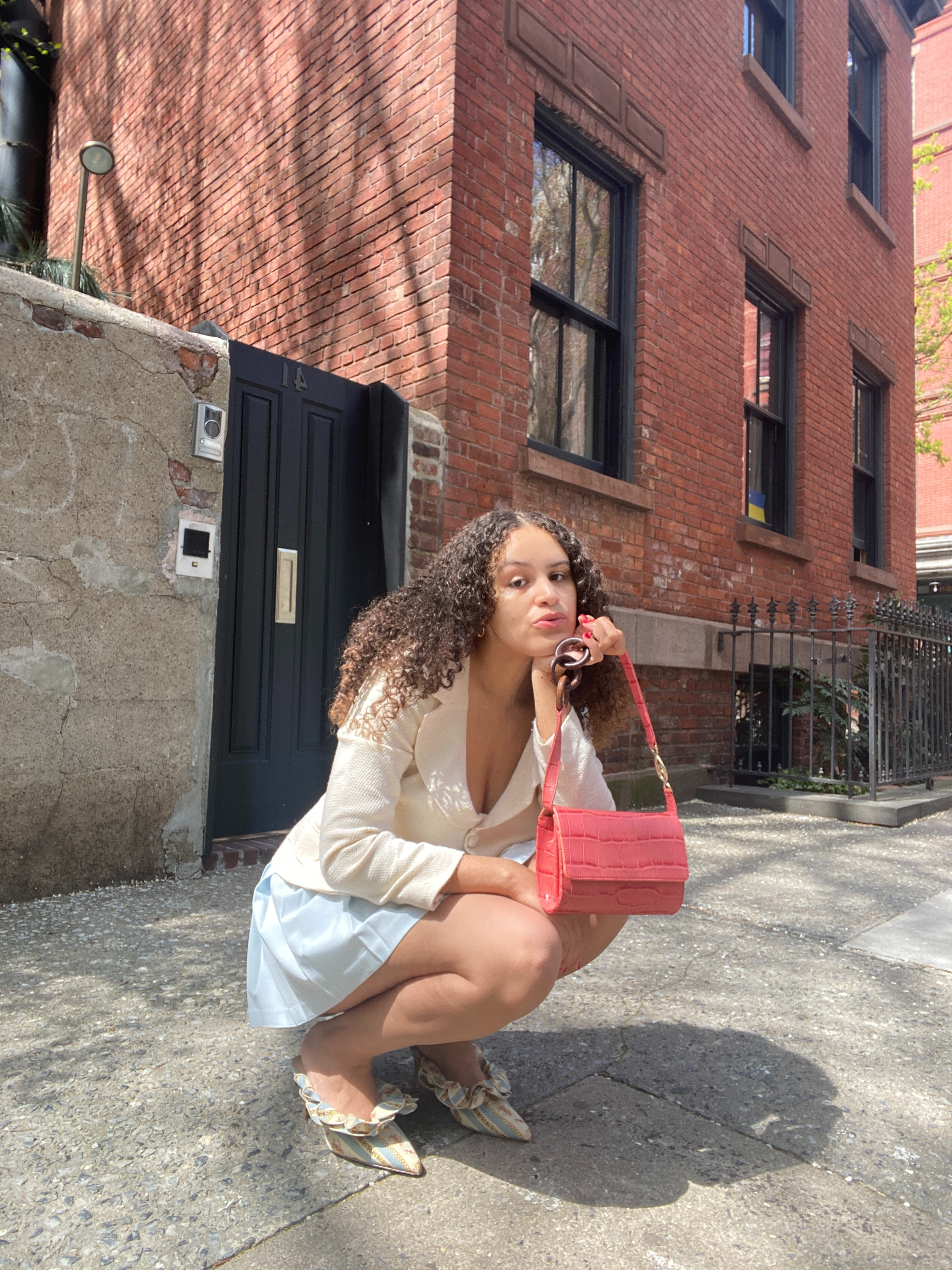
Jasmine Fox-Suliaman is a freelance writer and editor living in New York City. What began as a pastime (blogging on Tumblr) transformed into a lifelong passion for unveiling the connection between fashion and culture on the internet and in real life. Over the last decade, she's melded her extensive edit and social background to various on-staff positions at Who What Wear, MyDomaine, and Byrdie. More recently, she’s become a freelance contributor to other publications including Vogue, Editorialist, and The Cut. Off the clock, you can find her clutching her cell phone as she's constantly scrolling through TikTok and The RealReal, in search of the next cool thing.
